MESSENGER EXCLUSIVE Avlon Comments on Manhattan Ties, Goroff Asserts Her Candidacy
By Matt Meduri
With just under a week to go before Tuesday’s Democratic primary for New York’s First Congressional District, The Messenger spoke with candidates Nancy Goroff (D-Stony Brook) and John Avlon (D-Gramercy Park), namely regarding our previous report on Avlon’s Manhattan ties.
In April, The Messenger obtained New York City tax records showing the bill of sale for Avlon’s 2015 purchase of 149 East 19 Street, Unit 6, in Gramercy Park. The property type is described as a “single residential co-op unit.”
The unit is part of a six-unit co-op that is run by the Chanler House Corp, spanning the addresses of 147-149 East 19 Street.
According to NYC Department of Finance Records, the Chanler House Corp.’s property tax bill has six units enrolled in the condo/co-op tax abatement program, which stipulates that properties are only eligible if tenants are primary residents.
The building’s tax block is listed #875 and its tax lot is listed as #38, cross-referenced by records from the NYC Department of Finance and the NYC Department of Buildings.
Continued on page 3
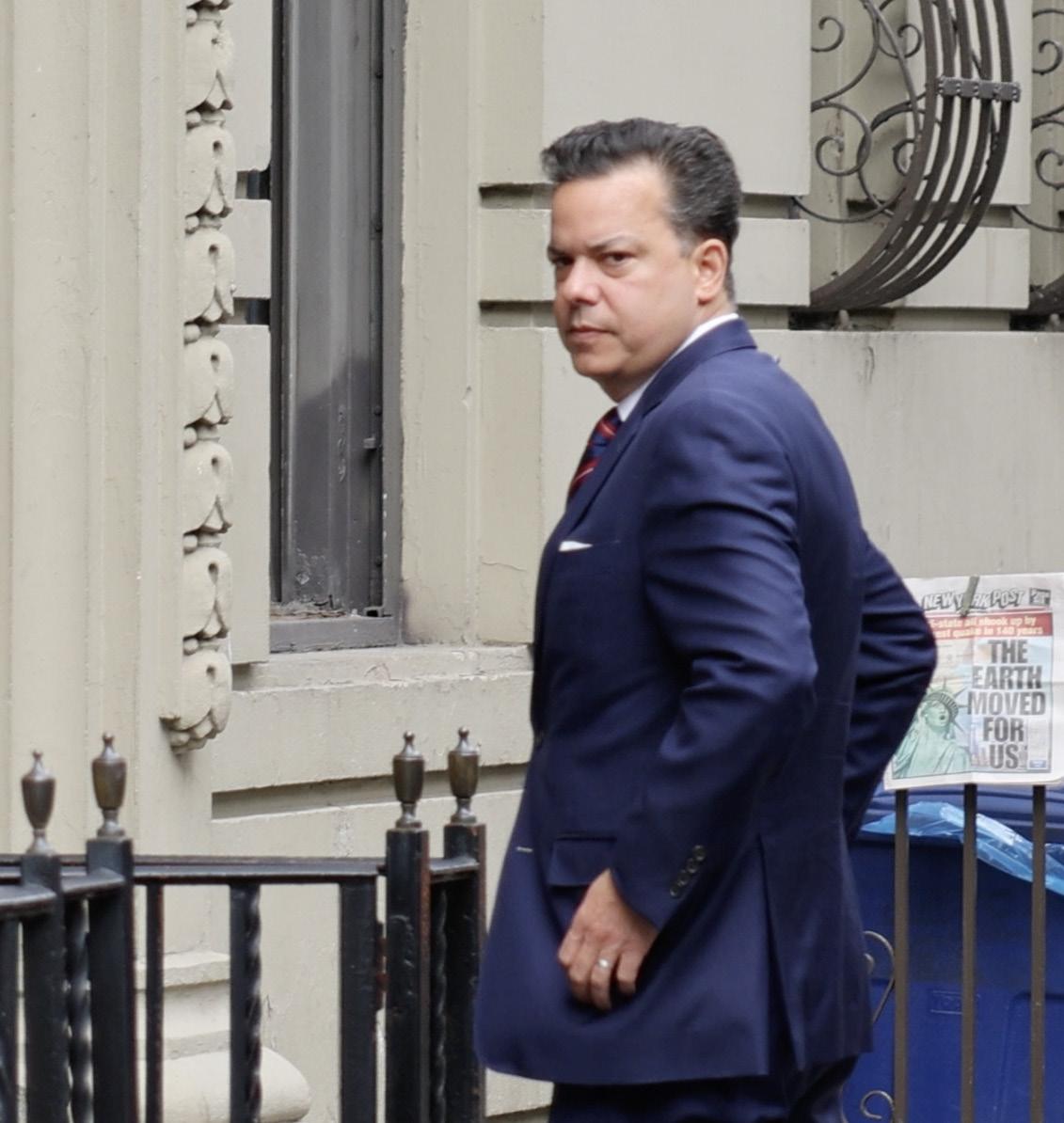


 By James Haupt
By James Haupt
Posillico Donates New Parking Lot to Smithtown Emergency Food Pantry
With food shortages becoming more frequent, it’s great to see the community work together to provide awareness and support to those in need. One organization in particular that has worked tirelessly to solve this problem is the Smithtown Emergency Food Pantry.
The organization has been a guest of the Episcopal Church of St. Thomas of Canterbury for over forty years. Its success comes from donors and volunteers who devote their time and services.
This past Friday, June 14, Posillico Materials paved the driveway leading up to the pantry’s location at the church.
“I’m indebted to all of the volunteers that are here,” said Senator Mario Mattera (R-St.James). “I appreciate them very much for what they have done for the community in need.”
Senator Mattera has established a great relationship with Pat Westlake, who has been director of the pantry for fourteen years. The organization has been making amazing strides under her leadership. This most recent project demonstrates that.
Continued on page 10

FULL STORIES ON: Kings Park Railyard Page 10
Don’t Forget To Look For In The Centerfold Every Week! School Highlights Sachem Passes Budget Revote Page 8 Thursday, June 20, 2024 ~ Volume 136 ~ Issue Number 31 ~ $1.00
New York COVID Report Released Page 5
(Left to right) Food Pantry Director Pat Westlake, Posillico V.P. Chuck Forte, Councilman Lohmann, Supervisor Wehrheim, Senator Mattera, Father Purchal, Anthony Millizi (Credit - Matt Meduri)
Avlon outside his NYC home on April 6.

A Walk Towards Grace Monthly Bereavement Series








Contact Us Call Us 631-265-3500 In Person 558 Portion Rd., Ronkonkoma, NY 11779 Mail P.O. Box 925, Smithtown, NY 11787 Display Advertising Publisher@MessengerPapers.com Legal Notices & Classifieds Advertising Legals@MessengerPapers.com Obituaries Editor@MessengerPapers.com News News@MessengerPapers.com Messenger Papers Inc. SMITHTOWN | BROOKHAVEN | ISLIP Messenger Papers Inc. SMITHTOWN | BROOKHAVEN | ISLIP DISTRIBUTION & CIRCULATION MANAGER Tim Walz DELIVERY PERSONNEL PJ Balzer Joe Cuminale Colin Newman Chris Revere PUBLISHER Diane Caudullo EDITOR-IN-CHIEF Matt Meduri STAFF REPORTER Cait Crudden ART PRODUCTION MANAGER Sergio A. Fabbri CONTRIBUTORS PJ Balzer Peter Chidichimo James Haupt OFFICE MANAGER & ACCOUNTS RECEIVABLE Kim Revere PROOFREADER Giavanna Rudilosso SOCIAL MEDIA Madison Warren Published by Messenger Papers, Inc. Smithtown, NY 11787-0925 Signature: ______________________________ Smithtown Messenger Brookhaven Messenger Islip Messenger Scan the QR code to Subscribe to... * *All current paying subscribers are eligble. Space is Limited. RSVP Required. or Visit Branchfh.com/grief-group This inclusive gathering open to everyone. Even if Branch did not serve your family. Guests are welcome and encouraged.
LEARN ABOUT: Various aspects of grief Coping mechanisms Strategies for rebuilding life after loss WHEN: The 3rd Saturday of every month 11am – 12pm WHERE: Branch Funeral Home of Commack 2115 Jericho Turnpike, Commack, NY Call (631) 493.7200 BRANCH FUNERAL HOMES BRANCHFH.COM OUR CONVENIENT LOCATIONS: Branch Funeral Home of Miller Place Branch Funeral Home of Smithtown Melissa Coyle Licensed Clinical Social Worker (LCSW-R) © Out compete Marketing MESSENGER MESSENGER MESSENGER www www.MessengerPapers.com Messenger Papers LI @MessengerPapers @MessengerPapers @MessengerPapers The Messenger Papers
Published by Messenger Papers, Inc.
Continued from front cover
Thursday, June 20, 2024
MESSENGER EXCLUSIVE:
Avlon Comments on Manhattan Ties, Goroff Asserts Her Candidacy
Skokiaan, LLC was filed in 2017 to the Manhattan address. Skokiaan was listed as the grantee for the 2017 purchase of a Sag Harbor home, 70 John Street, for nearly $1.5 million. Avlon has been registered to vote at the Sag Harbor address since 2020.
The Messenger submitted a Freedom of Information Law (FOIL) request to the Suffolk County Board of Elections (BoE) for Avlon’s voter profile. The FOIL shows Avlon voted absentee from the Sag Harbor address in the 2021, 2022, and 2023 general elections. The 2022 midterms was the last time congressional races were on the ballot, including NY-01, the seat that Avlon is hoping to contest in November.
The Messenger also found a listing for 70 John Street, Sag Harbor, on apartments.com, a rental listing website. The rental was listed in 2018 with lease agreements for the summer months included.
Additionally, Avlon, a former CNN anchor, was recorded and photographed entering and leaving the Manhattan property on April 6 and April 7.
A spokesperson for Avlon said that Avlon was in Manhattan attending a wedding for people who also live in Sag Harbor. The spokesperson also said that the apartments.com rental listing has not been updated since 2018. Finally, the spokesperson said that Avlon took the Census in 2020 and lives in Sag Harbor.
The Messenger also heard from a spokesperson for Nancy Goroff, professor emerita of chemistry and former Chair of the Chemistry Department at Stony Brook University. Goroff ran for NY-01 in 2020 against then-Congressman Lee Zeldin (R-Shirley), losing to him by about ten points. Goroff is vying against Avlon in Tuesday’s primary for the right to take on Congressman Nick LaLota (R) in November.
“Nancy Goroff has been in Suffolk County for years fighting for Long Islanders. She’s the only candidate in this race with a record of fighting for reproductive freedom, beating extremists, defending our public schools and kids, and working to build a better economy for everyone,” said the spokesperson. “While Nancy Goroff was on Long Island teaching at Stony Brook, fighting for reproductive rights, and beating right-wing extremists, John Avlon was in Manhattan, trying to elect a Republican president, working for a right-wing think tank, and founding a dark money group that attacks Democrats.”
The spokesperson for Ms. Goroff also told The Messenger that Goroff has rallied supporters since her 2020 congressional run, dispelling Avlon’s claims that her status as an underperformer makes her the weaker candidate on Tuesday’s ballot.
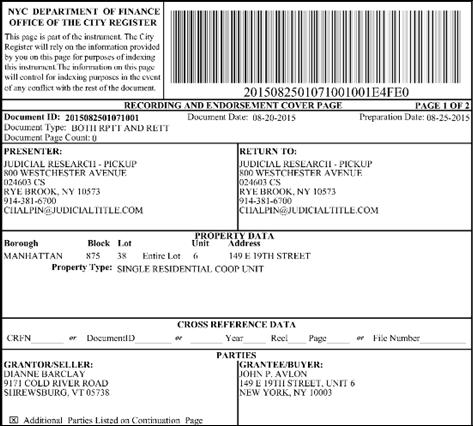
“Since last running for office, Nancy and a group of Long Island moms started a nonprofit to fight against extremists who were attacking our public schools and kids,” said the spokesperson. “Through this group, Nancy has beaten more than two dozen extremists who are running for school board. Nancy is the only candidate in this race who has actually fought against extremists at the ballot box and won.”
The primary campaign has been a relatively nasty one, with Goroff calling Avlon a “Manhattan elitist” and Avlon calling Goroff a “progressive hero.”
Avlon helped found the No Labels movement, a political organization that seeks to promote centrism and bipartisanship through what it calls the “commonsense majority.” Several high-profile politicians, including Senator Joe Manchin (D-WV), sparked rumors of a possible No Labels ticket for president, but the organization is not running a candidate this year.
southern Brookhaven from Lake Ronkonkoma to Manorville and the Moriches. Finally, NY-01 includes most of Huntington Township, including all of its communities except Huntington hamlet, Huntington Station, Cold Spring Harbor, Halesite, and the villages of Huntington Bay and Lloyd Harbor.

As of June 5, Avlon has raised $622,433 to Goroff’s $125,799. Both candidates had almost $600,000 in cash on hand as the primary race entered the final stretch.
The winner of Tuesday’s primary will face Congressman LaLota in the fall.
New York’s First Congressional District encompasses the majority of Suffolk County. Large in total area, it contains the entire townships of East Hampton, Riverhead, Shelter Island, Smithtown, Southampton, and Southold. The district also contains the northern half of Brookhaven, spanning from Stony Brook to Wading River, and central and
USPS No. 499-220
Official Newspaper for County of Suffolk, S.C. Department of Consumer Affairs, Village of Head of the Harbor, Village of Nissequogue, Inc., Village of the Branch, Hauppauge, Kings Park, Commack, Smithtown School District.
Published every Thursday by: Messenger Papers, Inc. 558 Portion Road, Suite B Ronkonkoma, NY 11779
Email: editor@messengerpapers.com www.messengerpapers.com
The district is viewed as Republican-leaning. The GOP has held the seat for the better part of a decade, commencing with Lee Zeldin’s ousting of Tim Bishop (D-Sag Harbor) in 2014. Zeldin narrowly won re-election over Manhattanite Perry Gershon (D) in 2018, and doubled his margin over Goroff in 2020. Zeldin forwent another term in Congress to run for governor of New York in 2022.
After the remedial congressional map was enacted in 2021, after a Democratic gerrymander was overturned by the New York Court of Appeals, the district became more competitive, taking in all of Huntington Town and none of southeastern Brookhaven. The slight shifts make the current iteration of NY-01 slightly more Republican-leaning than it was in 2022. The shift also exchanged the aforementioned parts of Huntington with neighboring NY-03, which might act as a boon to Congressman Tom Suozzi’s (D-Glen Cove) bid for a full term this year.
The district’s slightly red hue makes for something of an uphill battle for either Goroff or Avlon in November. Although Avlon has called NY-01 a “majority maker” in terms of balance of power in the House, the district has not flipped in nearly a decade, and most major pundits and forecasters predict the district is likely to stay in Republican hands.
Entered as a second class matter at the Post Office of Smithtown, NY, under act of December 28, 1879.
Periodicals postage paid out of Smithtown, NY. This newspaper will not be liable for errors appearing in any advertisement beyond the cost of the space occupied by the error.
The Smithtown Messenger is a community newspaper serving Smithtown, Kings Park, St. James, Nesconset, Hauppauge, Commack, and Stony Brook
The opinions expressed in byline articles, letters and columns are those of the author and not necessarily those of Messenger Papers, Inc, its publishers or editors. Pictures submitted for publication remain property of the publisher.
Postmaster: Send address changes to Smithtown Messenger, P.O. Box 925, Smithtown, NY 11787
News
3
By Cait Crudden
LaLota Secures $40 Million for EPA’s Long Island Sound Geographic Program
Congressman Nick LaLota (R, NY-01) has announced a significant victory for Long Island’s environmental conservation efforts, securing $40 million in federal funding for the Environmental Protection Agency’s (EPA) Long Island Sound Geographic Program. The substantial allocation represents a major investment in preserving and restoring the ecological health of one of the nation’s most treasured estuarine ecosystems.
The Long Island Sound, a vital body of water bordered by New York and Connecticut, is renowned for its rich biodiversity, scenic beauty, and cultural significance. However, in recent decades, the Sound has faced numerous environmental challenges, including pollution, habitat loss, and declining water quality, threatening the health of aquatic ecosystems and the communities that depend on them.

Congressman LaLota’s successful bipartisan advocacy for increased funding for the EPA’s Long Island Sound Geographic Program comes at a crucial time for the region, as stakeholders work to address pressing environmental issues and safeguard the Sound for future generations. The $40 million allocation will support a wide range of projects and initiatives aimed at improving water quality, restoring habitat, and enhancing public access to the Long Island Sound.
“From fishing to tourism to its role as a critical natural resource, the Long Island Sound is much more than a body of water, it is a way of life. I’m thrilled to announce that I was able to secure $40 million to preserve the Sound in this year’s government funding process,” remarked LaLota. “This vital funding will help address pollution, improve water quality, restore important habitats, and protect the Sound for decades to come. The Sound provides invaluable resources to Long Island families,
and I am committed to its preservation to ensure a healthier environment for future generations”.
The Long Island Sound Geographic Program, administered by the EPA in collaboration with state and local partners, focuses on addressing key environmental priorities identified by stakeholders in the region. These priorities include reducing nutrient pollution, restoring wetlands and shoreline habitats, and enhancing recreational opportunities for residents and visitors alike.
“This funding supports so many critical clean water initiatives, including the Unified Water Study, which Save the Sound launched to enable groups around Long Island Sound to collect consistent, comparable water quality data from our bays and harbors. Now in its eighth season, the Unified Water Study features 27 partner groups, including Save the Sound, monitoring 46 bays and harbors along the margins of the Sound,” said Denise Stranko, Executive Vice President of Programs for Save the Sound. “The more we can track and document the impact of nitrogen pollution, the more effectively we can work to protect the environmental health of those bays and harbors. We appreciate Representative LaLota’s efforts in securing this essential federal funding”.
The $40 million in federal funding secured by Congressman LaLota for the EPA’s Long Island Sound Geographic Program reflects a shared commitment to protecting and preserving this invaluable natural resource. As implementation of the program moves forward, stakeholders are optimistic about the positive impact it will have on the health and vitality of the Long Island Sound and the communities that depend on it for recreation, livelihoods, and cultural heritage.

4 Thursday, June 20, 2024 News Published by Messenger Papers, Inc.
Sunset on Long Island Sound (Credit - Wikimedia Commons - Jbellin171)
Published by Messenger Papers, Inc.
‘Rushed and Uncoordinated:’ Olson Group Released Report on NY’s COVID Reponse
By Matt Meduri
New York led the country in navigating uncharted waters with the onset of the COVID-19 Pandemic in March 2020. Then-
Governor Andrew Cuomo (D) ordered lockdowns across the state, closing schools, non-essential businesses, and other forms of commerce and tourism.
At the time, Cuomo asked for the blame and wrath of citizens to be laid on him, not local leaders and elected officials.
Shortly thereafter, Cuomo and the State came under significant fire for the sweeping lockdowns, lagging economic recovery relative to the rest of the country, and the controversial decision to admit COVID-positive or symptompresenting patients in nursing homes, with virtually no negotiations or options for nursing home staff, residents, and residents’ families.
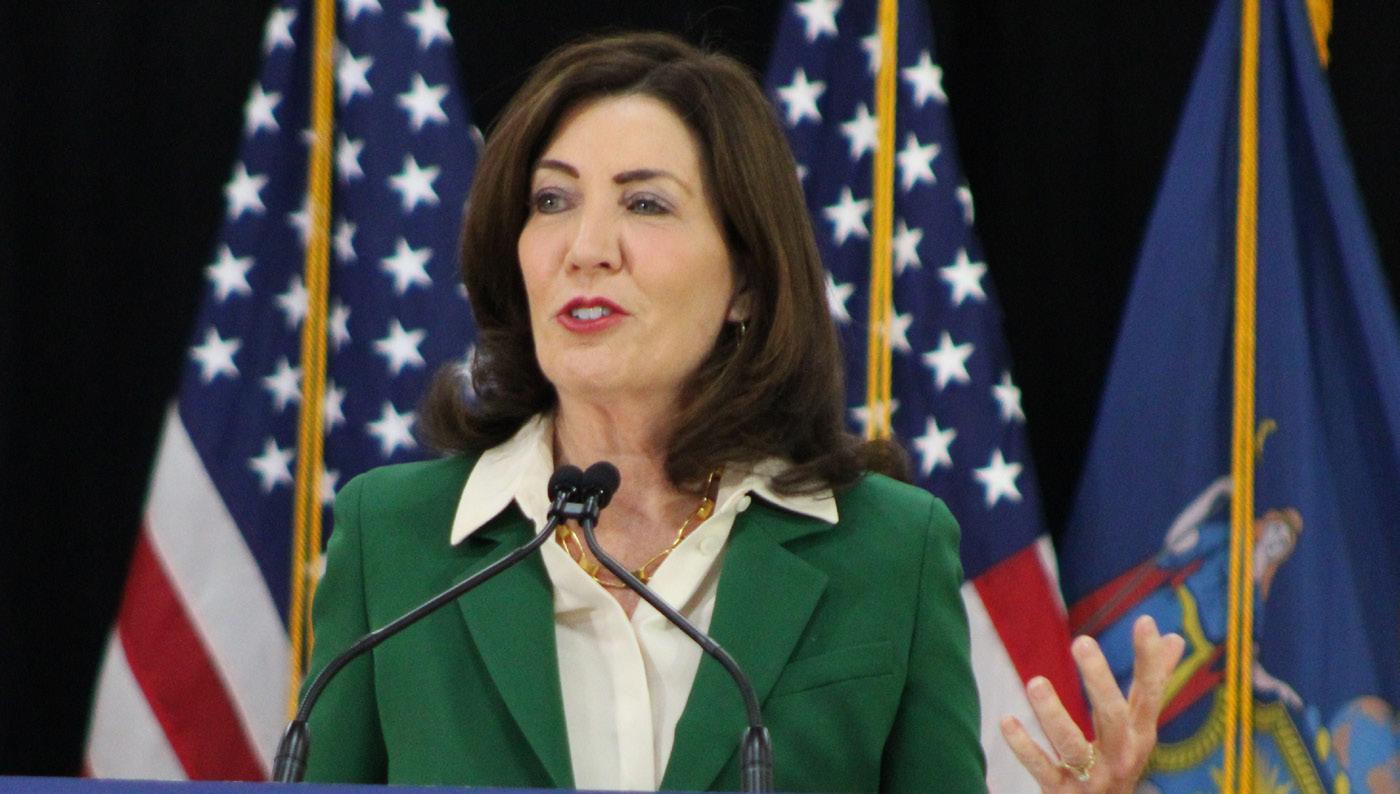
The Olson Group, a Virginia-based consulting firm, has released its long-awaited report, after multiple roadblocks from State government.
The report finds that Governor Cuomo acted outside his authority to micromanage the state’s response to the pandemic from the executive office, resulting in great confusion, dysfunction, and unpreparedness in fending off the novel coronavirus.
The $4.3 million dollar taxpayer-funded, 262-page report says that Cuomo made a “significant and unnecessary mistake” when he absolved municipalities of local control and ignored pre-established Department of Health protocols to essentially govern pandemic response himself.
The DoH already had plans in place to establish community-based vaccination sites. Cuomo instead took to setting up “hub hospitals” to inoculate New Yorkers, despite the fact that the hospitals lacked capacities to carry out vaccinations of the public.
“The structures developed through hard-won experience from events including 9/11 and Hurricane Sandy were largely ignored and the state’s chief executive office served as the central point of the response,” the report reads. “Although decisive actions were widely praised during the early stages of the pandemic, his [Cuomo] failure to shift to full incorporation of the state’s established institutions in coordinating the ongoing response operation resulted in unnecessary confusion at a time when New Yorkers needed clarity.”
The report also slams Cuomo’s decision to populate nursing homes with infected or symptom-presenting patients, as well as criticizes the State’s reporting of nursing home deaths. The report says the actions were “lacking in transparency.”
also his micromanaging in other areas of state commerce affected by the pandemic. The report highlights shortsightedness from the executive office in trying to bolster low milk supplies across the state.
The State ordered three hundred tractortrailer loads of raw milk to be rerouted from dairy manufacturers and sent directly to bottling plants. The decision led to a surplus of milk, which then expired and/or had to be discarded.
Rich Azzopardi, a spokesman for Cuomo, has openly criticized former President Donald Trump (R-FL) for the national response to the virus and has defended Cuomo amidst the release of the report.
“His daily press briefings were internationally recognized for providing the facts amid a chaotic lack of a national response to this pandemic where 1.2 million Americans lost their lives,” said Azzopardi. “While this report cuts through the political garbage that has consumed the nursing home issue and points out how circumstances were consistent nationwide, it’s ridiculous to suggest that this pandemic response be treated the same as H1N1 or Legionnaires outbreaks.”
Governor Kathy Hochul (D), then Lieutenant Governor at the time of the pandemic, did not offer many comments on the report, but fell short of defending her former boss.
“We knew that things had to be done differently, they had to be done better and we had to prepare for the possibility that this would happen again,” said Hochul, adding that extra funds for the State Office of Emergency Management and a $1.7 billion investment in a new research lab are initiatives she has taken to better prepare New York for a similar scenario.
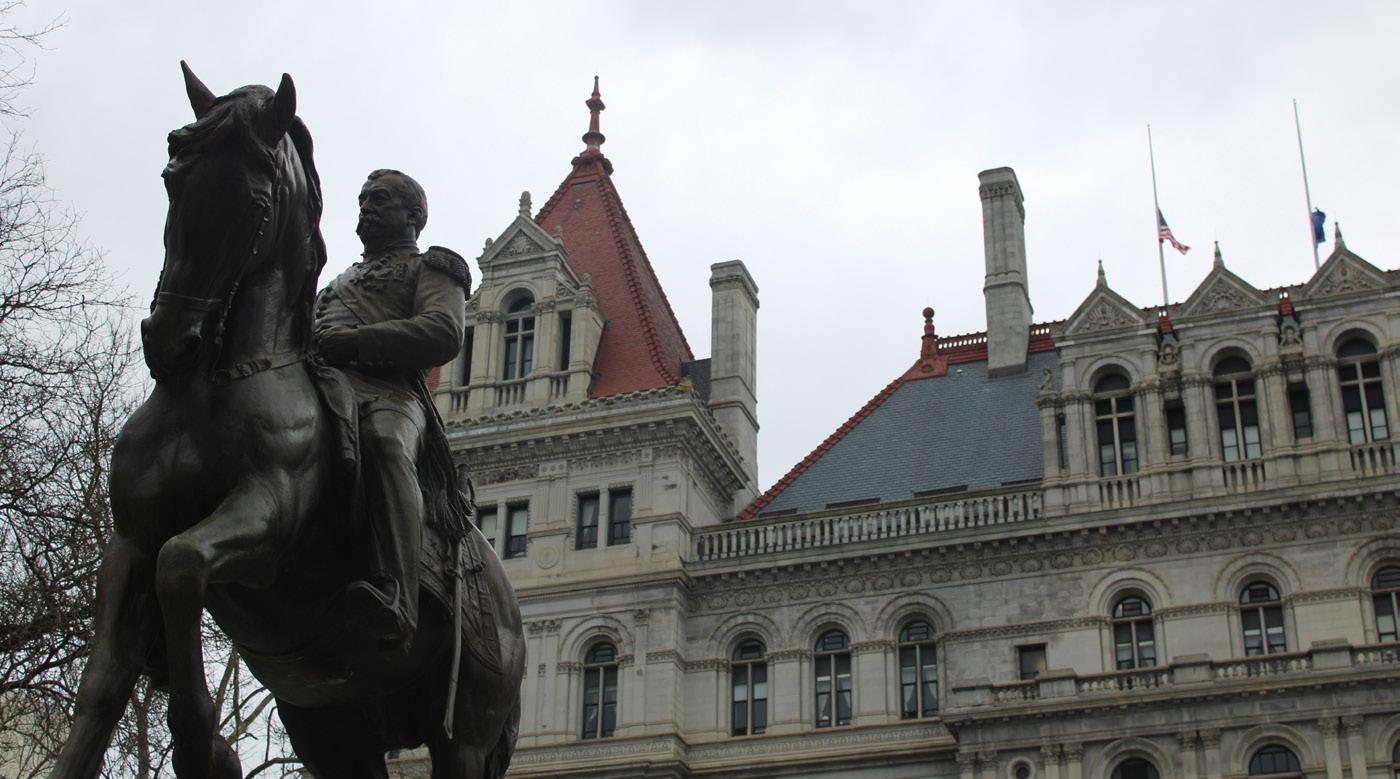
“The state did not consider the appearance of impropriety related to how it was reporting COVID-19 nursing home deaths until the public was already upset, having noticed and reported the discrepancies,” the report states.
The report’s release comes off the heels of Cuomo’s testimony in front of the House Select Subcommittee on the Coronavirus Pandemic. Republican legislators have accused Cuomo of “deflecting responsibility” for the nursing home scandal, one the report says is in line with the “theme of mistrust” in the response to the virus. Cuomo blamed an unnamed State DoH employee for drafting the decision and said it was not mandatory. Nursing homes were required to take in patients regardless of their COVID test results and presentation of symptoms.
Congressman Marc Molinaro (R, NY-19) expanded on Cuomo’s claims that directing patients to nursing homes mirrored federal guidelines during last week’s hearing.
“They [Cuomo and his then-staff] want to assert that that order is exactly the same as the federal [Center for Medicare and Medicaid Services guidelines], which it is not,” said Molinaro. “The state order says, ‘You shall take back individuals and you cannot deny them solely on the basis of COVID,’ which left [nursing homes] no option but to accept individuals that we knew would cause risk to the other patients.”
Congressman Ami Bera (D, CA-06), a doctor and former chief medical examiner for Sacramento County called Cuomo’s directive “medical malpractice” at a May 2023 hearing.
The report not only criticizes Cuomo’s response from a health perspective, but
Former Congressman and 2022 gubernatorial candidate Lee Zeldin (R-Shirley), slammed Cuomo, Hochul, and even the Olson Group not only for the controversial handling of the pandemic, but also the timing of the report’s release just a day after the legislative session in Albany ended.
“In predictably corrupted New York fashion, after Kathy Hochul initially punted this report past her 2022 election campaign, this massively delayed After Action Report didn’t get released until a Friday just after the state legislative session ends,” Zeldin said in a statement. “This is clearly timed to be late enough so that Albany legislators would be out of town and public hearings couldn’t be scheduled, but early enough to hopefully be buried over a weekend and long summer so that it wouldn’t be politically damaging for the November 5 elections.”
Zeldin also mentioned Hochul’s governance over the tail end of the pandemic and New York’s lagged recovery and return to normalcy against other states.
“Substantively, of course, this not-so-independent consultant avoids taking Kathy Hochul to task for forcing 3-5 year olds to be the only New Yorkers required to wear masks, and for an extensive period of time. Of course, the report refused to dig into Hochul awarding massively overpriced, no-bid contracts to top campaign donors,” said Zeldin. “There is also bad news here for anyone reviewing this After Action Report hoping for transparency on COVID tests being given to administration friends and family at private residences, done by State Health Department personnel, with the samples moved to the front of the line at the state lab. Even the content on Andrew Cuomo’s deadly nursing home order and coverup is filled with excuses and defenses.
Zeldin called for in-depth investigations and further scrutiny from legislators.
“High profile state legislative hearings should be called immediately to go over this report with a fine tooth comb,” said Zeldin. “Legislators and reporters should dig deep on the many issues the obviously not so independent consultant decided to leave out of the report, inquire why, and get answers about the cause of the extraordinarily long delays, and absurd timing for this release.”
This is not a fight that us families wanted or ever expected that we’d have,” said Tracey Alvino, Director of Voices for Seniors, in a FOX News interview. “We need to see this through to the end, and we’re not going to stop until we hold Andrew Cuomo and all of his cronies in the Cuomo crime syndicate responsible.”
Alvino lost her father in a nursing home due to the controversial New York policy. Voices for Seniors is a 501(c)(4) not for profit founded after many families lost relatives in nursing homes during the pandemic.
Thursday,
2024 5 State News
June 20,
State Capitol Building (Credit - Matt Meduri)
Governor Kathy Hochul (Credit - Matt Meduri)
John Avlon (D-’Sag Harbor’)
With the Democratic primary in NY-01 coming to a close, it’s safe to say that this year’s election has contained yet another all-to-familiar theme: off-Island carpetbaggers looking to cash in on the political clout that Suffolk County wields as the most populous suburban county in the nation.
An Avlon spokesperson insisted to us that Avlon was in the city in April for a wedding for people who also live in Sag Harbor. The Messenger observed Avlon entering and leaving his apartment multiple times that weekend, and obtained tax documents that show his unit’s involvement in the condo/co-op tax abatement program offered by New York City. In order for a property owner to qualify for the program, tenants must make units in said property their primary residences.
Even Nancy Goroff (D-Stony Brook), to whom we’re ideologically opposed but can at least respect her for being a lifelong Suffolk County resident, has taken shots of Avlon’s NYC ties, going as far as to call him a “Manhattan elitist.”
Technically, Avlon is registered to vote at his Sag Harbor address, but FOIL records from the Suffolk Board of Election show he voted absentee in the general elections of
2021, 2022, and 2023. What’s ironic is the very election in which he’s participating was on the ballot in 2022, and he voted absentee in that election.
Voter registration at an address doesn’t necessarily imply full-time residency. In fact, it’s been shown to not even prove residency at all. Former Congressman Steve Watkins (R, KS-02) had his short-lived political career ended when they found that his Kansas address at which he was registered to vote was a UPS store.
Suffice it to say, we’re not buying any ties Avlon might have to Suffolk, as frivolous as they might be. We had Randy Altschuler (R) in 2010 and 2012, who was last spotted donating to Dave Calone’s (D-Setauket) failed 2023 bid for County Executive, Perry Gershon (D), who was aptly named “Park Avenue Perry” in his 2018 run for NY-01, then Michelle Bond, the D.C.-based crypto queen who had big money and big names behind her, but no local endorsements and groups.
Suffolk’s saga as a lighthouse for carpetbaggers only continues with 2024. It’s been a fun ride while it’s lasted, but if Avlon wins Tuesday’s primary vote, it will certainly only get bumpier.
Hochul’s 180s: Fare is Foul and Foul is Fare
It’s a rare sight when an elected official makes a decision that somehow manages to annoy everyone in all quadrants of the political spectrum.
First, Hochul took it upon herself to quickly quash the MTA’s congestion pricing plan, a decision that, predictably, angered the most liberal New York City residents to the most conservative suburbanites the state has to offer.
The first problem was her sharp turnaround just days before Albany’s legislative session ended. The plan had her support for months and was set to take effect later this summer. But Hochul likely stuck her finger in the air and sensed political headwinds are not blowing in a favorable direction for Democrats ahead of November, and quickly balked at the congestion tax.
New York City and MTA officials alike were shocked at the about-face move, while New York City residents and commuters expressed deep concern for the integrity of their infrastructure. Many fear that without the expected revenue generated by the nowindefinitely-postponed congestion tax, subways will fall apart and NYC’s mass transit system will be kneecapped until further notice.
Meanwhile, Hochul’s dissenters found her second thoughts disingenuous and almost intentionally misleading, especially in a last-minute move to score political points with voters who continue to sour on her and the Democratic brand altogether. They’re not taking her desperate attempt to appeal to the working-class commuters seriously, and if there’s one thing voters don’t like, it’s being pandered to.
But what’s really amazing is that nearly everyone on all edges of the political spectrum seem to be in agreement that this is a cheap stalling tactic ahead of Election Day. Democrats can’t stand she’ll possibly let the mass transit system deteriorate - not that the MTA hasn’t
acted fiscally responsible or anything - to score quick Election Day points, while Republicans can smell the pandering from a mile away, knowing full well that the congestion plan will be back on the docket after November.
In terms of congestion pricing, fare seems foul and foul seems fare.
Hochul’s second 180 comes in the form of banning face coverings on subway systems. Masks were always banned on the subways since the 1800s, as protestors even then would cower behind them to hide their identities while attempting intimidation tactics or committing acts of protest outside the tolerable realm of political participation.
After lagging far behind the nation in removing masks for New Yorkers, most notably schoolchildren, Hochul now sees the value in banning the face coverings in subways to hopefully curb the rises in anti-semitic attacks and rhetoric, and hopefully, curb subway violence altogether.
We’re not sure if it will have the desired outcome, but we actually do support this initiative. Protest is a right granted to all Americans under the Bill of Rights. We’re wary of recent targeting of Americans by government agencies simply for attending protests or rallies, but overall, if you have to hide your identity, then there’s probably a good reason you don’t want to be seen, or you’re likely considering acts punishable by law.
And at this point, if you’re still wearing a mask to shield yourself from COVID, that’s your prerogative, but we’ve got a Mario Cuomo Bridge to sell you.
It takes true talent and political tact to please everyone on all sides of the aisle, and even then, there will still be a decently-sized group of people who can’t stand such an elected official anyway. But it’s almost more impressive that one can unite an entire state against him or herself with one rash decision.
COVID Report Shows What We Already Knew
The Olson Group’s report on the State’s handling of the COVID-19 Pandemic has been released at long last, and it doesn’t reveal much besides what many had already surmised.
Briefly, the report widely criticizes former Governor Andrew Cuomo’s (D) usurpation of local powers to effectively dictate the state’s response to the coronavirus from the executive office. Everything from vaccination rollouts to trying to influence food supplies had Cuomo’s involvement. Almost every decision had the makings of a Rube Goldberg Machine that invariably made each aspect of New York’s response less effective and more confusing than necessary.
The report appropriately states that at a time when New Yorker’s needed clarity and transparency, Cuomo gave them the direct opposite of that.
Cuomo always had an ego, but he wasn’t always a terrible governor. It was until 2018, when Democrats formed a trifecta and Albany and nationalized politics took the helm in almost every state, that Cuomo gave into the progressive tactics and started letting his ego get the best of him.
Ceremoniously presiding over bail reform, sanctuary city and state statuses, and the botched response to the pandemic are apparently all the earmarks of a book deal, with a slew of sexual harassment allegations as the cherry on top of the whole thing.
Cuomo’s arrogance also did not adequately prepare Kathy Hochul (D) for the state’s top job. Her status as his running mate in 2014 and 2018 was simply to balance the ticket with a female candidate from Upstate New York. Talks were in the works of dropping her in favor of an NYC progressive, but she nonetheless weathered a PR stunt to boost his prospects and set up another eventual kingmaker in the Empire State.
However, Cuomo keeping her in the dark for so long did not pay off when she was thrust into the spotlight amid his quick resignation in August 2021, the same time when he was facing mounting calls for resignation and investigations due to his sage wisdom to force nursing homes to accept COVID-positive or symptom-presenting patients, no exceptions.
Hochul already wasn’t up to snuff for the job as it was, but adding on the mountain of controversy and angst from the public desperate to move past mask mandates and lockdown measures certainly didn’t help her case.
Now, after much rock-kicking, the report has come out. We sincerely hope that this
keeps the fire under Cuomo lit, so that his conduct may be properly investigated and prosecuted, as justice still needs to be served to thousands of families across the state who lost relatives over a decision the report says was “lacking in transparency.” Furthermore, the report says that the way the State reported those nursing home-related deaths was not considered until public outcry made it a much larger problem than they had previously assumed.
Perhaps the most egregious chapter in this whole tale is that of Cuomo’s continued arrogance. Cuomo used the famous “who cares?” line when asked about the nursing home deaths, effectively saying that it didn’t matter how or where people died, it just mattered that people died. Unfortunately for Cuomo, the deaths could have been tens of thousands below the casualties New York suffered, had it not been for the unconscionable nursing home order.
Cuomo again invoked this line at a recent hearing before the House Select Subcommittee on the Coronavirus Pandemic, either showing his arrogance knows no bounds, or he is simply convinced his decision was sound.
Either way, the report’s findings show that the Governor commandeered power and oversight where unnecessary, slowed the state’s response and recovery rates dramatically, and made decisions that, even in hindsight, provide no silver linings or shreds of conscientiousness.
To add insult to injury, Hochul kicked the report past the 2022 gubernatorial election, likely to save herself from the righteous wrath of the public, as she was vicariously involved in the state’s handling of the pandemic during her time as lieutenant governor. Timing seems to be Hochul’s side once again as the report came out just a day after the legislative calendar in Albany ended. This largely hampers efforts to have timely press conferences and hearings while state legislators are spending time with their families or taking vacations after a grueling end-of-session marathon.
Now, the Olson Group has been forced by Hochul to sign a nondisclosure agreement (NDA), effectively putting a gag order on the firm from discussing the report with news organizations.
After four years since the pandemic began, one thing remains certain: transparency is not Albany’s strong suit.
6 Thursday,
Editorial Published by Messenger Papers, Inc.
June 20, 2024
2024 Legislative Session Missed the Mark on Major Issues
By Assembly Minority Leader Will Barclay
The closing of the 2024 Legislative Session looked a lot like the end of many that have come before it; a lot of bills were passed—many in the dead of night while most of the state was asleep—and measures New Yorkers actually needed to see included with respect to public safety, outmigration, and affordability were left out.
Crime and public safety remain persistent problems. The migrant crisis warranted a $2.4 billion commitment from taxpayers in the state budget. Taxes and fees on businesses remain oppressive and far too many New Yorkers are not happy with the direction of the state. Not addressing these problems with direct, targeted legislation makes little sense and ignores the concerns millions of New Yorkers express to their representatives.
I’ve repeatedly asked my colleagues on the other side of the aisle this question: When New York leads the country in residents leaving for other states, does that mean our policies are working, or do we need a dramatic course correction? The answer seems obvious to everyone except those setting the same status quo policy.
Instead of making everyday life more affordable, Democrats pushed environmental policies that will raise rates for consumers while doing little to improve the environment. Instead of making comprehensive improvements to bad criminal justice policies like bail reform, the parole system or Raise the Age, Democrats passed a bill addressing only retail theft. And instead of offering some form of widespread tax relief to overburdened New Yorkers, Democrats raised state spending to a record high $239.2 billion in a budget passed in the dark of night.
Our problems are not going anywhere, but Assembly Republicans will continue to push our colleagues, the Governor, and our Senate counterparts to fix what is broken.
No session of the Legislature is going to be perfect. My growing concern is that the proposals New Yorkers want to see passed are not only being rejected, but the problems they aim to address are not even on the Democrats’ radar. There was not only a lack of effort on their part, but a lack of understanding. After six months of debates and voting, New York is still not headed in the right direction.
Fortunately, the end of session does not mean our work is over, and our members will continue to fight for measures that put our state on a better path.
If you have any questions or comments on this or any other state issue, or if you would like to be added to my mailing list or receive my newsletter, please contact my office. My office can be reached by mail at 19 Canalview Mall, Fulton, NY 13069 and by email at barclayw@nyassembly.gov. You may also find me, Assembly Minority Leader Will Barclay, on Facebook or Twitter at @WillABarclay.
Assemblyman Will Barclay (R-Pulaski) is the Assembly Minority Leader and has represented the 120th Assembly District since 2003. The 120th District contains most of Oswego County and parts of Jefferson and Onondaga counties.

The Media’s Disgraceful Lie About So-Called ‘Fake’ Electors
By Steve Levy
The concept of one presidential candidate cobbling together alternative delegates after a presidential election has occurred in at least three presidential races in U.S. history. But only in 2020 did the media begin labeling alternative electors as being “fake” electors.
And only after Donald Trump empaneled such electors did politically motivated prosecutors deem them illegal.
The fact is, it is not illegal for a presidential candidate to designate alternative electors in a state where the election results are in dispute. https://www.gilderlehrman.org/ history-resources/essays/contentious-election-1876
However, our mainstream media, which is consumed by its left-wing bias and Trump Derangement Syndrome, has gone to a new level of advocacy by definitively stating that the establishment of such alternative electors is illegal. Thus, they disingenuously label them as fake.
Apparently, they never labeled the alternative electors empaneled in the 1960 presidential election in Hawaii or in various states in the election of 1876 as being illegal or fake. The Hawaii count originally called for Richard Nixon (R-CA) was overturned on a recount, allowing the alternative electors cobbled together by John F. Kennedy (D-MA) to cast the state’s electoral votes for the U.S. Senator from Massachusetts.
By labeling the designation of alternative electors as fake, the fake media automatically gives the reader the false impression that the process of creating alternative electors is an illegal scheme designed to incite an insurrection.
You may have a problem with the concept of alternative electors, but if you don’t like it, the remedy is to seek a change in the United States Constitution and federal law, not to seek the imprisonment of attorneys or the party faithful who latch onto this perfectly legal process sanctioned by the federal law.
There were many things within the Constitution — a document crafted almost 250 years ago — that seem outdated and anti-egalitarian today.
Let’s not forget that many of the founders wanted to place a check on popular will, and, therefore, had Senators chosen not directly by the voters but by the members of the House of Representatives. That outdated concept was jettisoned to the ash heap of history with the passage of the 17th Amendment in 1913.
We also might not like that members of Congress have the authority to reject the certification of a particular state’s election results. But, quite obviously, this process is sanctioned by the Constitution and federal law.
The mainstream Democratic media outlets love to give the uninformed reader the impression that failing to certify an election is an illegal unpatriotic act, but only when it’s exercised by a Republican, as was the case in 2020. Little to nothing is said about the numerous times Democrats have exercised this prerogative — the most ironic and noteworthy being Congressman Jamie Raskin
(D, MD-08), who was a lead prosecutor in the Trump January 6 hearings after having objected to certifying the results of Trump’s 2016 election win.
As noted above, we may dislike this process, but if we want to change it, alter the law or get a constitutional amendment; don’t try to imprison those who properly exercise this option that has been legally available to others for two centuries.
Which brings us back to the so-called “fake” electors.
If there is a dispute over a state’s election results, one of the candidates may cobble together a slate of electors different from those promoted by the state legislature.
But here’s the kicker that the biased media almost always omits: the alternative slate of electors do not automatically rule the day. They don’t displace the electors put forth by the state Legislature to the Electoral College. Instead, the matter is left to the courts to decipher. Once the courts have spoken, the slate deemed valid will be able to cast its votes at the electoral college gathering, and the other slate will not.
This is exactly what attorneys John Chesebro and Rudy Giuliani had advised Donald Trump after a number of questions arose regarding the sanctity of elections in various states ranging from Arizona to Wisconsin to Georgia.
Neither Chesebro, Giuliani, nor presidential Chief of Staff Mark Meadows, ever said that this slate of alternative electors would run roughshod on Capitol Hill and take the reins of power. They understood, however, that the law required that this alternative slate be in place prior to the court challenge or winning in court would be worthless. The opportunity to have created the slate would have passed weeks earlier.
The concept was more fully apparent in the 1876 election of President Samuel Tilden (D-NJ). Oh wait, Tilden, who won the popular vote, never became president because Congressional supporters of his rival Rutherford B. Hayes (R-OH) had challenged the validity of voting outcomes in a number of states. That dispute never made it to the judicial process since members of Congress formulated the Great Compromise of 1877 where Congress agreed to make Hayes the president, while agreeing to end Northern occupation of the South after the Civil War.
The process might have been uglier than making sausage, but it was entirely legal.
No one was indicted. The ultimately victorious electors were never disparaged as being fake.
Steve Levy is President of Common Sense Strategies, a political consulting firm. He served as Suffolk County Executive, as a NYS Assemblyman, and host of “The Steve Levy Radio Show.” He is the author of “Solutions to America’s Problems” and “Bias in the Media.” www.SteveLevy.info, Twitter @ SteveLevyNY, steve@commonsensestrategies.com

Op-Ed 7 Thursday,
2024 Published
Messenger Papers, Inc.
June 20,
by
8 School Budget Results
Sachem Central School District Passes Budget in Revote
By Matt Meduri
May’s school board elections and budgets votes saw only two school districts countywide reject their budget propositions: West Babylon and Sachem Central.
Both budgets were slated to pierce the tax cap. Sachem’s budget would have carried a 4.87% tax levy increase. Since the budget would have pierced the tax cap, 60% of voters were required to vote in favor of it. Although it received a majority of support, it still fell largely short of the 60% threshold.
The failure of the May budget triggered a budget revote for June 18 at Samoset Middle School.
The new budget passed with 3,355 votes with 1,573 against - a 68%-32% margin. The district is home to over 86,000 residents and contains over 12,000 students.
The budget for the 2024-2025 fiscal year comes in the form of $374,374,186 and carries a 1.92% tax levy increase. This is compliant with the district’s tax cap.
The estimated monthly increase to taxpayers is $10.35 for Brookhaven residents, $11.33 to Islip residents, and $10.67 to Smithtown residents.
“Following the defeat of our budget on May 21, the district faced tough decisions as we worked diligently to reduce expenditures,” the district said in their newsletter ahead of the vote. “While we navigated these budgetary constraints, our commitment to providing quality education remained unwavering. We understand the importance of maintaining programs such as core curriculum and support services for our students. Therefore, our budget reductions were strategic, with the goal of minimizing the impact on these essential areas. Those reductions, coupled with a $12.6 million allocation of reserves and fund balance, were the driving forces behind our ability to create a tax- cap compliant budget.”
The passage of the revote budget avoids the implementation of the contingency budget, which would have required, under state law, that the tax levy increase be capped at 0%. This would have required the district to make a further $9,226,000 in reductions.
Administrative costs increased by 0.29%. These costs include the Board of Education, Central and Administration, Business Administration and Finance, Personnel and Communications, Security, Safety, and Data Processing, Districtwide Insurance and BOCES, Curriculum and Instruction, and Benefits. The total administrative costs for this fiscal year are $30,716,384, an increase of nearly $90,000 over last year.
The budget includes the cost associated with the fifth year of a five-year contract for large bus transportation with Towne Bus, the second year of a five-year contract for van service with WE Transport and the first year of a five-year contract for van service with Orange County Transit for Pupil Transportation Services including home to school transportation athletic/field trips and summer transportation Approval of
Program costs have increased 2.89%. Program costs consist of Personnel and Communication, Curriculum and Instruction, Special Education, Servicing Pupils with Special Needs, Occupational Education, Special Programs, Instructional Media, Pupil Services, District Transportation, Benefits, and Interfund Transfers. The total price tag on these services comes out to $293,529,956, an increase of more than $8 million over last year.
Capital Expenditures saw the highest net change of 4.59%. These include Buildings and Grounds, Purchase of Buses, Benefits, Bonded Indebtedness, and Capital Projects. These account for $50,127,846 of the budget, an increase of almost $2.2 million over last year.
As far as revenues, the district is seeing a 2.89% increase from last year. The passed budget revenues account for $374,374,186. The district saw a 1.86% increase in State Aid, worth $139,316,158. The property tax levy of 1.92% carries an additional $4 million in revenue, $211,851,459 total.
According to various sources, the passed budget will see the reduction of twenty-one jobs, adding onto the seventy cuts revealed in May. The cutbacks will increase elementary class sizes by about one student per class. The budget will also eliminate sixth-grade foreign language classes.
“This was a very challenging process, but we are pleased to be able to continue to provide the type of quality education our students and families have grown accustomed to,” said Christopher Pellettieri, the Sachem superintendent, in a statement released after Tuesday’s vote. “Now we can move forward planning for the 2024-25 school year and beyond.”
With the budget approvals in Sachem and West Babylon, all 124 public school districts on Long Island are set to enter the next fiscal year with voter-approved budget plans. The next school year begins July 1.
The two districts are among seventeen across the state that passed their budgets on revote. The only district in New York that failed on its second round of vote was the Berne-Knox-Westerlo Central School District in the Albany area.
Sachem’s Tuesday evening vote was conducted with paper ballots, as the Suffolk County Board of Elections said that electronic machines were unavailable due to the upcoming primary elections next week.
Thursday,
2024
June 20,
Published by Messenger Papers, Inc.
ADMINISTRATION Board of Education Central Administration Business Administration/Finance Personnel/Communications Security/Safety/Data Processing Districtwide Insurance/BOCES Curriculum and Instruction Benefits Total PROGRAM Personnel/Communications Curriculum and Instruction Special Education Servicing Pupils with Special Needs Occupational Education Special Programs Instructional Media Pupil Services District Transportation Benefits Interfund Transfers Total CAPITAL Buildings and Grounds Purchase of Buses Benefits Bonded Indebtedness Capital Projects Total 2 0 2 4 - 2 0 2 5 P R O P O S E D B U D G E T E X P E N D I T U R E S 2023-2024 Budget $222,901 482,340 2,331,178 1,721,360 4,661,656 3,962,340 11,297,813 5,947,190 $30,626,778 $70,200 92,180,744 54,076,662 6,455,228 2,620,930 185,000 9,509,610 15,483,106 23,984,551 79,775,683 965,000 $285,306,714 $16,952,557 269 000 6,439,283 15,740,141 8,526,955 $47,927,936 $ Change $(63,116) 8,529 (128,581) 85,077 526,137 267,918 (981,600) 375,242 $89,606 $0 (2,708,562) 4,030,687 203,695 436,570 45,215 (610,185) (237,380) 2,882,194 4,288,008 (107,000) $8,223,242 $537,051 (269,000) 625,690 833,124 473,045 $2,199,910 % Change -28 32% 1 77% -5 52% 4 94% 11 29% 6 76% -8 69% 6 31% 0 29% 0 00% -2 94% 7 45% 3 16% 16 66% 24 44% -6 42% -1 53% 12 02% 5 38% -11 09% 2.88% 3 17% -100 00% 9 72% 5 29% 5 55% 4 59% TOTAL EXPENDITURE BUDGET $363,861,428 2024-2025 Proposed Budget $159,785 490,869 2,202,597 1,806,437 5,187,793 4,230,258 10,316,213 6,322,432 $30,716,384 $70,200 89,472,182 58,107,349 6 658 923 3,057,500 230,215 8,899,425 15,245,726 26,866,745 84,063,691 858,000 $293,529,956 $17 489 6087,064,973 16,573,265 9,000,000 $50,127,846 $374,374,186 $10,512,758 2 89%
the budget by the voters of the school district will constitute approval of this multiyear contract
budget includes the cost associated with the third year of a four-year lease agreement for networked copiers
of the budget by the voters of the school district will constitute approval
this multiyear lease agreement State Aid Property Tax Levy Payment in Lieu of Taxes (PILOT) Other: Charges for Service Use of Money and Property Donations, Unclassified, Recoveries Medicaid Reimbursement Fund Balance/Reserves 2 0 2 4 - 2 0 2 5 P R O P O S E D B U D G E T R E V E N U E S 2023-2024 Budget $136,776,708 207,863,464 1,306,374 868,000 3,605,661 3,360,000 250,000 9 831 221 $ Change $2,539,450 3 987 995 204,7781,132,363 (200,000) 50,000 2,798,172 % Change 1 86% 1 92% 15 68% 0 00% 31 41% -5 95% 20 00% 28 46% Expenditures Revenues TOTAL REVENUE BUDGET $363,861,428 $374,374,186 $10,512,758 2 89% PROGRAM $293,529,956 CAPITAL ADMINISTRATION $50,127,846 $30,716,384 PROPERTY TAX LEVY $211,851,459 STATE AID $139 316 158 OTHER REVENUE $21,695,417 PILOT $1 511 152 2024-2025 Proposed Budget $139,316,158 211,851,459 1,511,152 868,000 4,738,024 3,160,000 300 000 12,629,393
This
Approval
of
















in each state, surpassing the minimums by large margins, in Alaska (3), Florida (30), Idaho (4), Iowa (6), Minnesota (10), Nebraska (5 split), Nevada (6), New Hampshire (4), New Jersey (14), New York (28), North Carolina (16), Ohio (17), Tennessee (11), and Washington (12). Signatures in these states will need to be verified by the respective secretaries of state to formally obtain ballot access.
In total, RFK has collected signatures or gained access in twenty-three states, collectively representing 310 electoral votes.
The campaign continues to race against the clock in several states. Illinois (19) requires 25,000 signatures by June 24, New Mexico (5) requires almost 3,600 by June 27, and Indiana (11) requires nearly 37,000 by July 1.
Ballot access initiatives are currently afoot in most of the country. Only three states have not yet opened their windows for petitioning. Rhode Island (4) begins on June 26, Wisconsin (10) opens on July 1, and Louisiana (8) opens on July 16.
RFK’s presence on the ballot and impact of the overall presidential race continues to remain unclear, as both parties assert he could be a benefit or a liability to both Joe Biden (DDE) and Trump.
However, RFK’s campaign may be growing into a more serious concern, as he has just become the first Independent candidate in decades to poll evenly with a major-party candidate.
A June 4-7 HarrisX poll of 857 registered voters in Utah finds Trump with 49% of the vote and Biden and Kennedy tied with 20% each. The same poll finds Trump capturing 57% of the vote to Biden’s 25% when Kennedy is removed from the equation.
Such a high level of support for a third-party presidential candidate is nothing to balk at; however, Utah is a state known
the state’s two congressional districts, Maine doesn’t attract much presidential attention on the campaign trail. Trump came within three points of upsetting Clinton in 2016, although Biden grew the margin back to nine points in 2020.
Maine is much more Independent-leaning and swingy than its New England counterparts. Again, Perot was able to secure second place with 30% of the vote in 1992 and managed to win three counties. Although Perot’s margins slipped nationally in 1996, he still managed 14% of the vote in Maine that year.
Ralph Nader’s (G-CT) 2000 campaign saw him take nearly 6% of the vote, while Gary Johnson’s (L-NM) 2016 run saw him receive just over 5%.
Theoretically, states like Maine and Utah are RFK’s best bet at trying to win counties, congressional districts, or states outright. Intrinsically libertarian states with historical third-party tendencies could be where he could siphon votes from the majority parties.
Regarding enthusiasm for the major-party candidates, the Trump campaign recently issued a statement regarding the launch of their TikTok account.
Since its creation just over two weeks ago, the account has received over a quarter-billion views, with 115 million views in just its first two days. The campaign also noted that Trump’s account has surpassed Biden’s 300,000 followers on the platform with 6.4 million of his own.
The Trump campaign has joined the platform in an effort to connect with younger voters, a key demographic of the Democratic voting bloc with whom Biden has struggled alarmingly in the polls.
State
In a surprising turn of events, Governor Kathy Hochul (D) has floated the idea of banning face masks and coverings in
“That makes a difference between staying open and closing,” Hochul said. “That means you can continue paying good wages to your workers.”
Local
Congressman Nick LaLota (R, NY-01) has recently announced over $1.8 million in federal funding for research grants at Stony Brook University. The additional funds now move the total secured for the university to nearly $19.5 million since LaLota’s tenure began last January.
The following projects are set to be financed through these grants:
• $1,075,000 for LSAMP BD: Stony Brook University SUNY LSAMP Alliance
• $100,000 for Planning: Mid-Scale Research Infrastructure-1 Community-scale Testbeds to Accelerate Climate Adaptation and Disaster Reduction Research
• $99,983 for Conference: International Year of Quantum (IYQ) Educational Leadership Conferences
• $398,750 for Clinical Research Related to Neurological Disorders
• $169,826 for Collaborative Research: Generation and Manipulation of Spatially Entangled States of Structured Photon Pairs with 2D Material Quantum Holograms
“Stony Brook’s world-class research and development projects deserve all the funding they need. The work done at Stony Brook has changed millions of lives already and I look forward to seeing what comes next,” said LaLota. “Every day federal dollars come to Suffolk County is a good day. I’ll always fight to make sure Suffolk comes first and that Stony Brook has the resources they need to support critical research and scientific advancements.”
Trump +1 43% Kennedy:15% 4/8-30DigitalResearch609RV Trump +2 45% 47% Trump 32% 50% MAINE MINNESOTA IOWA 42% 6/9-11McLaughlin& Associates 600 LV ThirdPartyTotal:11% DesMoinesRegister6/9-14632LV
Posillico Donates New Parking Lot to Smithtown Emergency Food Pantry
“This is such a blessing to us,” Westlake said. “We don’t get any funding. People just hear about us and donate. It’s neighbors taking care of neighbors.”
Senator Mattera has been involved with the organization for almost a year now after collaborating several times to make a safer and more visually appealing home for the pantry. Various businesses have worked on these projects, the most recent being Posillico, one of the largest paving companies on Long Island.
“Posillico is giving back to the community, that’s what I love about them,” Senator Mattera told The Messenger “They understood what was needed and they cared for the community.”
The company offered its services for what would’ve been a $40,000 paving job. Posillico worked hard for several hours to complete the paving job in one day. (Finished product pictured above)
“We always look to do charitable work,” said Chuck Forte, Vice President of Posillico and Division Manager of the Asphalt Division.
“Whatever we can do to give back to the community is always a plus for us.”


St. Thomas of Canterbury’s Father John Jeffrey Purchal, who has been with the church for almost six years, said that he was excited to get the work done and engage with the community.
“This is a project we have been struggling with for years,” Father Purchal said. “There’s excitement and gratitude for this getting done.”
Not only will this project make it safer for clients and volunteers to attend the food pantry, but it also helps raise awareness for the organization and the food shortages on Long Island. This is a growing issue that has been harming many residents.
“Prices have gone up,” Westlake told The Messenger. “Most of our clients are from the town of Smithtown. It’s an expensive place to live. They need gas for their cars. They need heat for their home. They need food. We can help them with food.”
The food pantry has a variety of clients with numerous reasons for their food insecurities.
This includes multigenerational families living together to save money, grandparents raising kids, people who have lost jobs, or people who have gotten sick.
“We have a lot of senior citizens who are just not making enough on their social security,” said Westlake. “Our numbers have definitely gone up. We help about 170 families every month. We estimate we give people seven days’ worth of food for three meals. We provide about 14,000 meals every month.”
The pantry also ensures that well-rounded diets and proper meals are given to families in need. Servings are proportioned by family and consist of vegetables, fruits, dairy, and other staples to ensure adequate nutrition.
The pantry also mentioned that due to such charitable donations from its associated churches and the community, they were able to give out turkeys, hams, and cooking and baking ingredients for Thanksgiving meals.
“This facility serves a lot more people than one would think all year round,” said Smithtown Supervisor Ed Wehrheim (R-Kings Park). “We thank you from the bottom of your hearts for what you’re doing here.”
“What Posillico is doing for the food pantry and the church is just such a wonderful thing,” said Smithtown Councilman Tom Lohmann (R-Smithtown).
The Smithtown Emergency Food Pantry continues to give its best efforts to help solve the food shortage problem. The growing support from the community, including officials like Senator Mattera and Supervisor Wehrheim, has helped the pantry receive something vital that it needs to give back to the community’s needs. The organization will celebrate its fortieth anniversary on July 1 as it will continue to build on its success and help those in need.
The Smithtown Emergency Food Pantry is located at 90 Edgewater Avenue in Smithtown and can be reached at 631-265-7676. The pantry is open from 10:00a.m. to 12:00p.m. on Tuesdays, Thursdays, and Saturdays.
Debate Continues on Kings Park Railyard
By Cait Crudden
Perhaps the most heavily discussed and debated municipal Smithtown issue is that of the Kings Park Railyard, an initiative that hopes to facilitate waste and construction debris disposal off Long Island. The project has an additional sense of urgency due to the impending closure of the Brookhaven landfill later this year.
However, the project has gained opposition from some members of the community, who cite environmental concerns, neighborhood characteristics, and quality of life as their primary reasons.
The project, proposed by Carlson Corporation, aims to establish a freight yard off the Port Jefferson rail line by Fort Salonga, Commack, East Northport, and Kings Park by Townline and Pulaski roads promises some economic growth and increased job opportunities for the region. It also will assist in transporting ash that is currently sent to Brookhaven’s Landfill prior to its closure in the future. Proponents of the project, including members of the Town Board, argue that it is the first of many steps in a multi-year process to get rid of waste out of the Town of Smithtown.

moved to the area for its quiet, residential character and worry about the impact this will also have on their home values and quality of life in their homes and neighborhoods.
Environmental and safety concerns also loom large in the opposition’s arguments. Critics fear that the freight yard could lead to air and water pollution, posing health risks to nearby residents and wildlife including asthma in children. Furthermore, worries about potential accidents involving freight trains and trucks carrying hazardous materials have fueled anxiety among those living close to the proposed site. Many acknowledge this site is necessary but are not pleased with the location choice.
Town Supervisor Ed Wehrheim (R-Kings Park) wrote in a letter to the Surface Transportation Board (STB) previously that “The town is supportive of Townline’s petition because there is mounting pressure on towns and villages due to the anticipated 2024 closing of the Town of Brookhaven’s Yaphank landfill facility. Smithtown’s residential and commercial solid waste and residential construction debris (“C&D”) is currently disposed of at the Brookhaven landfill. Smithtown’s solid waste is converted to ash at the Covanta waste-to-energy facility which then delivers the ash to the Brookhaven landfill. Alternative means of disposal and carting of C&D and ash off Long Island will be mandatory soon for municipal and non-municipal waste facilities.”
However, not all residents share this optimistic outlook. Many express deep-seated concerns regarding the potential negative impacts on their daily lives, citing safety concerns and the environment. Chief among these concerns is increased noise and air pollution from freight operations, heightened traffic congestion on local roads, and potential environmental degradation due to increased industrial activity. Many residents stated they
Despite these apprehensions, supporters of the Town Board’s decision point to stringent regulatory measures and ongoing assessments that will accompany the project. They argue that modern technologies and regulatory oversight will mitigate potential risks and ensure the project operates in harmony with the community and environment. Additionally, proponents highlight the economic benefits that could accrue from the freight yard, such as job creation and increased tax revenue, which they believe will strengthen Smithtown’s fiscal health and support local infrastructure improvements.
The STB is a federal agency tasked with regulating and deciding disputes regarding railroad projects, rates, mergers, and line sales, in addition to other transportation concerns. The STB’s Office of Environmental Analysis recently issued its Final Environmental Assessment for the project. In November 2022, Townline filed a petition seeking the STB’s approval for the project.
The proposed line would add 5,000 feet of new rail off the LIRR line. It would also add two daily New York Atlantic Railway (NYA) trains to the LIRR line five days per week. NYA facilitates freight rail service on the LIRR line alongside passenger trains.
As Smithtown prepares for the next phase of the Carlson Corp Freight Yard Project, both supporters and opponents are gearing up for continued dialogue and engagement. The Town Board’s decision marks a pivotal moment in Smithtown’s development trajectory, where the delicate balance between economic progress, pragmatic solutions and community well-being hangs in the balance.
Thursday, June 20, 2024 10 News Published by Messenger Papers, Inc.
Continued from front cover Credit: Matt Meduri
The proposed site of the Kings Park Railyard (Credit - Surface Transportation Board)
Dear Neighbors,
Long Island Community Hospital has served Suffolk County for over 65 years. We are proud to be a part of this community and dedicated to providing the highest quality care for you and your families.
In the last couple of years alone, we have hired more than 100 new physicians across a range of specialties.
Our team is raising the bar on care and services, including:
• The Knapp Cardiac Care Center: a full range of cardiac diagnosis, treatment, and rehabilitation services.
• A Level III Trauma Center: a facility providing care by emergency medicine physicians and board-certified critical care trauma surgeons.
• A hospital-based infusion unit for patients with neurologic conditions.
• A stroke center that has received Advanced Certification as a Primary Stroke Center by The Joint Commission.
• A robotic surgery program offering minimally invasive procedures and faster recovery times.
• Innovation in Orthopedics: We offer a “smart knee” replacement that provides real-time postoperative data.
• Inpatient and outpatient behavioral health services.
And, our affiliation with NYU Langone Health, the #1 physician practice network in the US, has added:
• The implementation of a single electronic medical record.
• The establishment of NYU Langone physician practices at 100 Hospital Road, across the street from our hospital.
• Plans for a new NYU Langone ambulatory surgery center in Patchogue.
We hope you never need us, but we’re here if you do.
Marc S. Adler, MD, MBA, FACP Chief of Hospital Operations Long Island Community Hospital


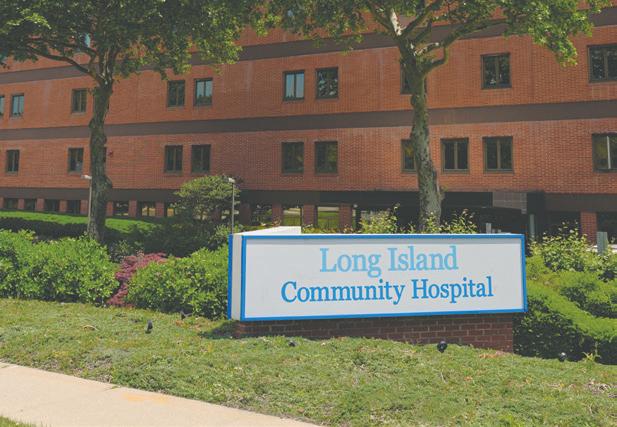


Smithtown MessengerBrookhaven MessengerIslip MessengerThursday, June 20, 2023
101 Hospital Road, Patchogue, NY 11772 • 631.654.7100 To find a physician, visit licommunityhospital.org/find-a-physician Source: 2023 Vizient Ambulatory Quality and Accountability Ranking. NYU Langone Health ranked #1 out of 62 participating ambulatory networks.
T:14"
Smithtown Brings Home Three Suffolk BOCES Model School Awards
The Smithtown Central School District was very well represented at the Western Suffolk BOCES Model Schools Awards Ceremony, held on June 4. Smithtown received three of five awards out of the 18 districts that make up Western Suffolk BOCES.
Kathleen Lamitola of Tackan Elementary, Learning to Read with Geodes with the Support of Google Earth; Donna Deluca and Lorraine McDermott of Nesaquake Middle School, Hero’s Journey Project, and Michelle Robinson of Tackan Elementary, Ozobot Ice Capades, were named Technology Integration Award winners.
For each of the three awards, Western Suffolk BOCES will provide $1,000 to be used for the school and/or classroom.
The district congratulates the teachers on their achievements.

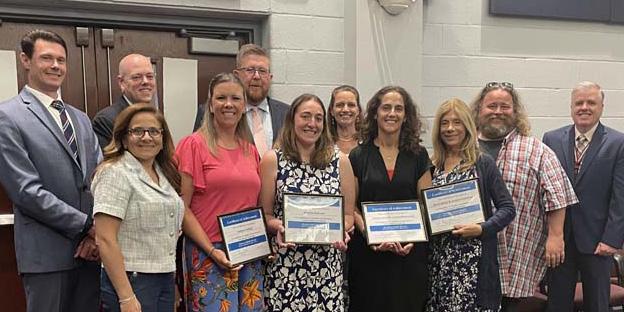
Accompsett Sixth Grade Student Accepted Into Juilliard Pre-College Program
Accompsett Middle School sixth grade student, Jinhan (Michael) Wang, has been accepted into The Juilliard School’s pre-college program as a student of the viola.
Jinhan, who explained it’s been his dream to become a musician, achieved the highest score of 100 at the NYSSMA level 6 for his age group. At Juilliard, he looks forward to improving his viola skills and eventually attending their college program.
Two pieces of music are particularly meaningful to Michael. The Stamitz Viola Concerto in D Major excites and uplifts him, while Bach’s Cello Suite No. 1 in G Major has a special quality.
“We are absolutely thrilled for Michael and his remarkable achievement of being accepted into the prestigious Juilliard School,” said Accompsett Middle School Principal Paul McNeil. “This is a testament to his exceptional talent, dedication and hard work. The entire AMS community extends our heartfelt congratulations to Michael and his family.”
Founded in 1905, The Juilliard School is a world leader in performing arts education.
Smithtown High School East and Smithtown High School West Honor Speakers

DYLAN SHEN, HSE
Regeneron STS Semifinalist
National Merit Scholarship Finalist
2023 American Society for Human Genetics,
DNA Essay Contest Honorable Mention
Qualified for American Invitational
Math Exam (AIME) in 2021, 2022, 2023
Long Island Science and Engineering
Fair 3rd place (2024)
Long Island Science Congress Honors
Award (2023)
GPA: 4.74
Science Olympiads: Qualified for State competition 3 times with school team
Pit Orchestra
National Honor Society
Math Honor Society
Science Honor Society
Cornell University

BRAYDEN STAHL, HSW
Starting Varsity Quarterback, All-State All-County All-League, Captain
Top scholar Athlete in Suffolk 3-year Symphonic Orchestra member
1st Chair Bass in
Chamber Orchestra Pit Band
Symphonic Orchestra
Symphonic Band
National Honor Society
Math Honor Society
Spanish Honor Society
Lockhaven University
12 School Highlights Thursday, June 20, 2024
Published by Messenger Papers, Inc.



Samoset Middle School Celebrates 20 Years
Samoset Middle School in the Sachem Central School District celebrated its 20th anniversary during a schoolwide celebration on June 10. Student-musicians kicked off the events with several performances while the guests of honor were welcomed. Teachers who have been at the building since its opening, along with retirees who helped lay the foundation of Samoset Middle School, were recognized during a brief ceremony.
“All these educators, past and present, brought to Samoset their passion, guidance and unwavering support that empowered generations of children to chase their dreams,” said current Samoset Middle School Principal Dr. Georgia Afxendiou.
Each of the original Samoset teachers and retirees were introduced during a processional, as eighth graders cheered on with Samoset signs in the crowd. Additionally, sixth and seventh graders watched the livestreamed event from the auditorium.
To keep the celebrations going after the ceremony, Samoset Middle School students participated in activities including lawn games, tie-dying shirts, face painting and enjoyed Italian ices. The event celebrated Samoset’s rich past, but also looked ahead to its future.
New Director of Music at Three Village
Ashley Ockner was approved as the district’s new director of music at the May 29 Three Village Central School District Board of Education meeting. The appointment is due to the upcoming retirement of Anthony Pollera and is effective July 1.
Ms. Ockner has been a member of the Three Village Central School District since 2015. She started at W.S. Mount Elementary School and currently teaches at R.C. Murphy Junior High School. Throughout her time in Three Village, Ms. Ockner has stepped into several leadership roles within the fine arts. She coordinated the district’s NYSSMA Satellite Festival for two years and managed the host site for the Suffolk County Music Educators’ Association Festival Concerts, ensuring a smooth event and collaborating between district staff and SCMEA leadership. Additionally, Ms. Ockner organized the R.C. Murphy Junior High School music department trips to Music in the Parks over the last several years.
Most recently, Ms. Ockner has served as an administration
intern within the district. In this role, she designed a comprehensive K-12 music restructuring plan to improve educational services to student-musicians. She also spearheaded the proposal for the district’s third grade band program.
Before her time in Three Village, Ms. Ockner was a music teacher in the Longwood Central School District and for the Paul Effman Music Service. She holds a bachelor’s degree from SUNY Potsdam’s Crane School of Music, as well as a master’s degree and certificate in educational leadership from Stony Brook University.
“I am honored and proud to be stepping into the role of director of music in Three Village,” Ms. Ockner said. “As both an alumna and an educator in this district, I am thrilled to be able to continue fostering the same passion for music that inspired me as a student and has motivated me as an educator. I look forward to serving our music teachers, district, community, and, most importantly, our young musicians in this capacity.”

Hauppauge MS Celebrates Students’ Exemplary Actions with Leadership Award

On June 10, the Hauppauge School District proudly recognized the four recipients of this year’s Community Leadership Award. This is Hauppauge’s first year in partnering with the Long Island Coalition Against Bullying. The Community Leadership of the Month Award is commissioned by LICAB as a way of rewarding those students who often go unsung but whose contributions toward their school community and those around them make the world a better place. The award recognizes students’ exemplary spirit, character and positive actions.
Ahead of receiving their awards, each student’s guidance counselor or teacher spoke about them, offering insights into the qualities and actions that afforded each of them the award. In addition to certificates of recognition, each student received a $75 reward from LICAB. Both LICAB and the Hauppauge School District hope to continue this wonderful recognition for years to come.
Congratulations to this school year’s recipients: Aydin Horasanli, Mia Inzirillo, Joseph Kaydanov, and Sienna Rosati.
Thursday, June 20, 2024 School Highlights 13 Published by Messenger Papers, Inc.
The Necessary Standard for American Education
The Life Cycle of a Bill
By Matt Meduri
The primary function of Congress, the legislative branch of the federal government, is to pass laws. The Constitution empowers both chambers of Congress, the House and the Senate, to create, modify, repeal, and pass laws, as well as to govern over budgetary measures, such as levying taxes, duties, imports, tariffs, etc. The legislative process follows roughly the same process for any legislative body in the U.S., but for this column, we’ll look at what the process entails for the U.S. Congress. Many, if not all, of these steps in the life cycle of a bill can be found in the New York State Legislature, as well as the Suffolk County Legislature.
Who Can Introduce Legislation?
Any sitting member of Congress can introduce a bill. This includes Representatives and Senators from all fifty states, as well as the delegates from the U.S. Territories. These delegates, hailing from American Samoa, Guam, the Northern Mariana Islands, Puerto Rico, and the U.S. Virgin Islands, can introduce legislation and sit on committees, but cannot cast actual votes on the floor of the House. The District of Columbia has a delegate who follows the same rules. D.C. and Puerto Rico have shadow Senators and shadow Representatives, who cannot sit on committees and sponsor bills. Their primary objectives are to lobby for statehood for their respective territories.
The Introduction of a Bill
When a bill is introduced in the House, it is placed in the bill hopper, a piece of furniture used as a receptacle for the legislation to be collected by the clerk of the House. A bill cannot be accepted unless it is signed by the primary sponsor. Members who cosponsor the bill on its date of introduction are considered original cosponsors. Members who cosponsor a bill after its introduction are considered additional cosponsors. The bill is then referred to the respective committee(s) for deliberation. After its final committee discharge, the primary sponsor’s name cannot be deleted from the bill. Cosponsors’ can have their names deleted with a unanimous-consent request or with that of the primary sponsor.
In the Senate, however, a sponsor introduces a bill to the Presiding Officer, the Vice President of the U.S. While not required, the formal procedure entails the Senator rise on the floor and verbally introduce the bill with a brief description. The bill must gain recognition of the Presiding Officer during the morning hour of business. Objection to a bill from any Senator postpones the bill until the next day. Unlimited multiple sponsorship of a bill is permitted in the Senate. Some legislation can even be requested, and marked as such, by the President of a member of the Cabinet. The bill is then assigned a number and sent to the Government Printing Office (GPO) for copies to be made.
Committee Action
It’s often said that the committee is where bills “go to die.” Here, they receive the most scrutiny and depending on the intent of the legislation or the sponsor(s), the party in power might not even act on it. A committee has no obligation to act on a bill, which is akin to the committee killing the legislation. All committees in a chamber of Congress are governed by the majority party in that chamber. Currently, Republicans control the House and its committees and Democrats control the Senate and all its committees. The member of Congress
from the majority party is considered the Chair of his/her respective committee(s), while the member of the minority party is considered the Ranking Member.
This column will seek to address the long-forgotten concept of civics and how it relates to American government in general, from the federal level to the local level. This column will explore Constitutional rights, the inner workings of government, the electoral process, and the obligations and privileges of citizens.

Before a bill is considered by a committee, the committee must obtain the input of the relevant government departments and agencies. These are often accompanied by reports from said agencies, discussing the necessity of enacting the legislation in question. The reports are not binding on the committee’s intention to hear or kill a bill. Committee Chairs can refer the bill to subcommittees, also composed of elected members of Congress, for further deliberation. Rules are then set on hearings and agenda.
The committee may then debate the bill, discuss its intent, and hear testimonies from agencies, stakeholders, or affected parties. The full committee votes on the “order to be reported,” which then allows the committee to hold a “mark-up” session, in which the legislation is amended. If a bill receives numerous amendments, the committee can order the introduction of a “clean bill,” in which the original legislation is tossed and the amended legislation receives a new bill number from the clerk and contains the proposed changes. The committee must approve or reject all amendments before a final passage vote.
After a report, the members of the committee can then prepare a written report that explains their support or opposition of the bill. They can also state why they seek their amendments to be adopted. The entire report is then sent back to the entire chamber and is placed on the legislative calendar.
Discharge petitions may be filed to bypass committees and send the bill to the floor.
Differences in House and Senate Floor Rules
The bill is placed on one of the four House calendars. The Speaker of the House and the Majority Leader decide what bills reach the floor and when, unless bills have been forced to the floor with a discharge petition.
In the Senate, legislation is placed on the calendar. The Executive Calendar encompasses treaties and nominations. The Senate Majority Leader schedules the legislation. Bills can be brought to the floor with a majority vote of the Senate.
Because the House is so large - 435 voting members - the Rules Committee often sets procedures for deliberation of the bill on the floor. A “closed rule” sets strict time limits on debate and closes the door on further amendments. Members can move for rules to be suspended or utilize the “Calendar Wednesday” procedure, in which each standing committee may bring up for consideration any bill that has been reported to the floor on or before the previous day. The procedure limits debate for each bill to two hours, with supporters and dissenters receiving equal time.
Debate of a bill requires that amendments are relevant to the subject of a bill and no riders are allowed. Riders are considered additional provisions of a bill that may or may not be relevant to its original intent. Riders might be considered “pork barrel” legislation, in which members of Congress attempt to attach “wins” for their home states or districts, regardless of the relevance of the provision to the original legislation.
When a bill is up for passage, a quorum call is conducted to ensure the House has enough members present - 218 - for a final vote. Without a quorum, the House will adjourn or the Sergeant at Arms will attempt to round up any absent members.
Because the Senate has just 100 voting memberstwo for each state - debate rules are virtually unlimited. Members are entitled to speak for as long as they wish. This rule is often used to “filibuster” legislation, a tactic that seeks to delay or significantly impede passage of a bill. If no other Senator wishes to speak, a Senator may have the floor for as long as he/she chooses.
Senator Strom Thurmond (D-SC) gave the longest Senate filibuster in history to date. Thurmond spoke for twenty-four hours and eighteen minutes against the Civil Rights Act of 1957. He also read the Declaration of Independence, the Bill of Rights, George Washington’s Farewell Address, and other historical documents to extend the time to wear out the chamber. The Civil Rights Act received a collective fifty-seven days’ worth of filibustering until its passage in June. One such filibustering Senator was Robert Byrd (D-WV), a former KKK klansman who spoke for over fourteen hours. Byrd died in 2010.
New York’s last Republican Senator Al D’Amato delivered the second-longest filibuster in history, at twenty-three hours and thirty minutes to stall debate on a military bill in 1986.
Recently, Senator Ted Cruz (R-TX) pulled an all-nighter to filibuster the Affordable Care Act in 2013. He spoke for twenty-one hours, famously reading Green Eggs and Ham to stall debate.
Filibusters can only be circumvented with a “cloture” vote, one to end debate. Cloture rules were adopted in 1917 and originally required a two-thirds majority to end a filibuster. In 1975, the Senate reduced the number of votes required to three-fifths.
Senate rules also allow riders and other provisions irrelevant to the legislation at hand.
Becoming Law
The chamber in which the bill originates votes on the bill. If a bill passes with a majority of the quorum, it advances to the other chamber for debate and passage. If a bill passes both chambers, it is sent to the President for signature. The president can then veto a bill outright, sending it back to Congress, who can then override his veto and make the bill law with a two-thirds vote of those present.
If the president does not sign a bill within ten days, it becomes law, as long as Congress is in session. The President can also “pocket veto” a bill, in which he chooses not to act on a legislation before it expires with the legislative calendar.
In 1997, Bill Clinton (D-AR) popularized the “line-item veto,” in which he invoked the Line Item Veto Act of 1996 to cancel certain, individual items in a bill presented to him. The law allowed the President to cancel only three types of fiscal measures: any item of new direct spending, a tax change benefitting a class of one hundred people or fewer, or a dollar amount of discretionary budget authority. While the act was never repealed, the Supreme Court ruled in 1998 that the act was unconstitutional.
If a bill fails to pass either chamber of Congress, the bill dies and must start from the beginning of its life cycle.
14 Civics 101 Thursday,
Published by Messenger Papers, Inc.
June 20, 2024
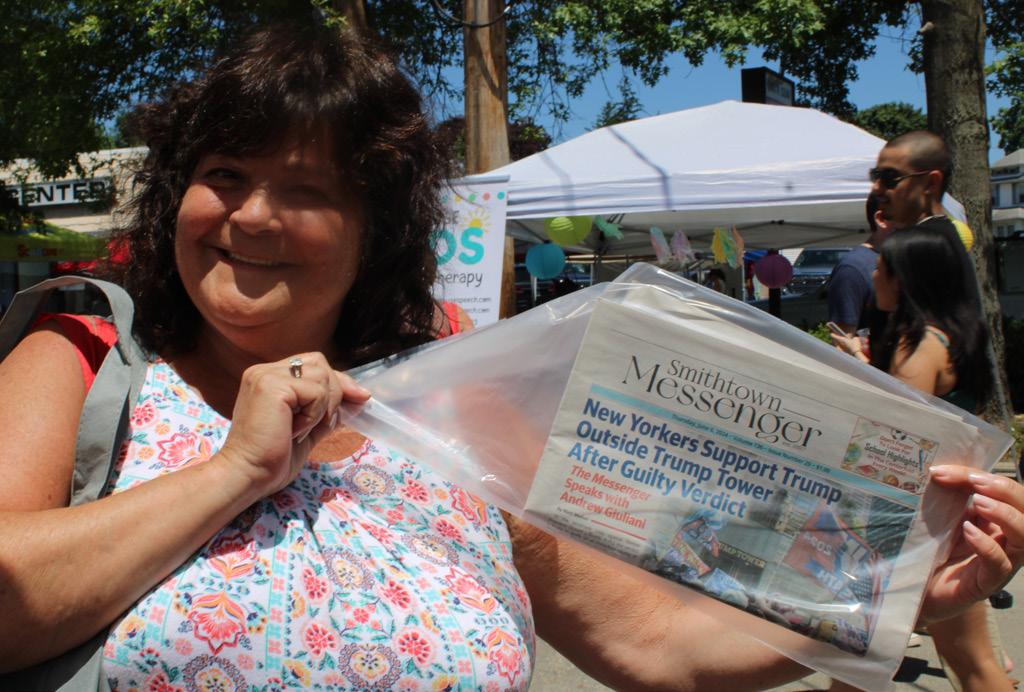
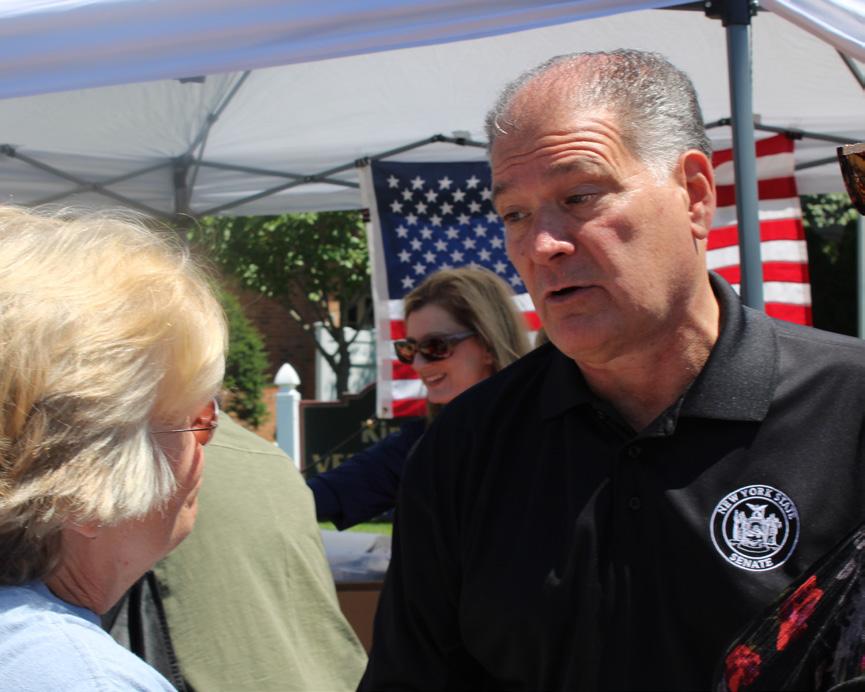








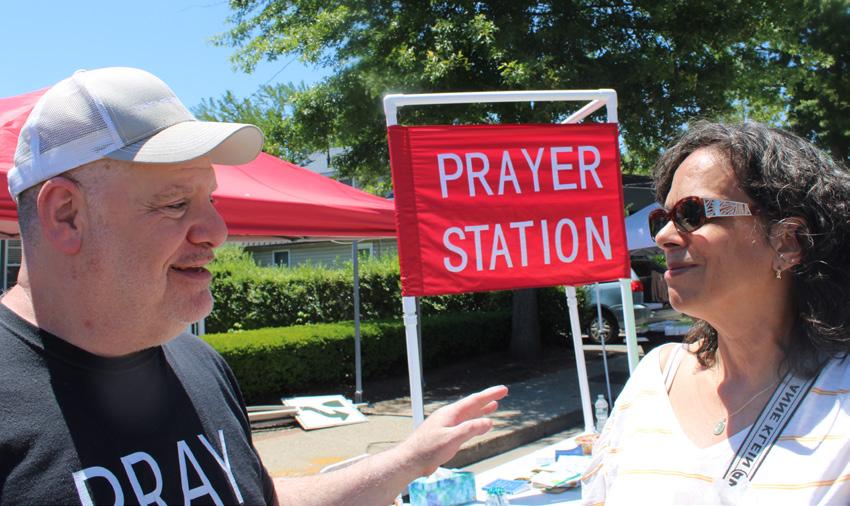

Thursday, June 20, 2024 Published by Messenger Papers, Inc. Around Town 15 Kings Park Day!
Photos by Matt Meduri
By PJ Balzer
It’s the lady sitting alone, talking to herself, at the bus stop you pass every day on the way to work. The foster kid who just packed their life into garbage bags and moved into another stranger’s home for the fourth time this year. The middle-aged man rummaging through the garbage can for a few smokable cigarette butts. The cashier at the local gas station that tries their best to get out a few kind sentences in English.
Our society’s citizens who can’t further our agendas most likely won’t vote for our favorite candidate. They aren’t able donate to our causes because they are the people that are in need of help. Many with lives marked by one trauma after another, having never fully recovered from the first. These are just some of the many unseen members of our society and community.
For most of us, life is pretty routine. Our parents encourage us to go to school, then college. We pick a career and look to get married. We make and save money in order to purchase the items that life tells us to. We start a family and purchase a golden retriever. We wrap this neat and tidy life behind a nice white picket fence.
Yet outside the picket fence and caught in the crevices of our community, there are people who are seriously struggling, not only struggling to pay bills and keep or find a roof over their head, as most of us are doing that these days, they are struggling to find the strength to get out of bed each day; struggling with personal hygiene; struggling with severe depression and hopelessness; struggling to find a dentist that will take out several rotten teeth without dental insurance; struggling with finding the will to keep living.
My wife and I have been doing street outreach for
Seeing the Unseen
over a decade now. We’ve spent a good amount of time at local bus stops, train stations, and sitting with other people behind dilapidated strip malls. We’ve had the privilege of getting to know, listen to, and pray for people who are completely unlike us. Someone once told me, “It’s easy to dislike people from a distance. Once you get to know people up close, you realize how alike we really are and how one diagnosis, one phone call, one car accident could so suddenly cast us into living in another person’s shoes,” possibly becoming yourself a person that society would rather not see.
We’ve witnessed God transform people’s lives all beginning with simply seeing them and stopping for them. We’ve also witnessed people stay the same and even die out in the streets. Thankfully, they died knowing that someone else did care for them and tried to help them though. A well-known homeless woman in our community said something to me once that has stayed with me since, “Thank you for seeing me, no one sees me anymore or maybe they are just tired of seeing me.”
America has been a relatively generous nation from its very inception. We still rank in the top three of the most giving nations in the world. The early settlers fled oppression while yearning for religious freedom. They ultimately found it and their lives began overflowing with generosity as a result. Nearly 248 years later, we are just as generous. Despite many hurdles and a system that we can all agree does have its flaws, I personally hope and pray that we stay a generous people, willing to see the unseen and offer help where we can. We are a better people and a more just and fair society when we stop to give the unseen and vulnerable members of our society the dignity that we each deserve.

“Then the King will say to those on His right hand, ‘Come, you blessed of My Father, inherit the kingdom prepared for you from the foundation of the world: for I was hungry and you gave Me food; I was thirsty and you gave Me drink; I was a stranger and you took Me in; I was naked and you clothed Me; I was sick and you visited Me; I was in prison and you came to Me.’
“Then the righteous will answer Him, saying, ‘Lord, when did we see You hungry and feed You, or thirsty and give You drink? When did we see You a stranger and take You in, or naked and clothe You? Or when did we see You sick, or in prison, and come to You?’ And the King will answer and say to them, ‘Assuredly, I say to you, inasmuch as you did it to one of the least of these My brethren, you did it to Me.”
(Matthew 25:34-40)

16 Thursday,
Messenger Perspective
June 20, 2024
Published by Messenger Papers, Inc.
Kansas Sues Pfizer of Misleading Marketing of COVID-19 Vaccine
By Matt Meduri
As reports and investigations into the nationwide handling of the COVID-19 Pandemic begin to unfold, namely the Olson Group report of former Governor Andrew Cuomo’s (D) executive oversight in New York, other states are beginning to take actions against other players in the response.
The State of Kansas is suing Pfizer over marketing tactics of their COVID-19 vaccine that they deem “misleading.”
The suit, led by Kansas Attorney General Kris Kobach (R) (pictured right), alleges that “Pfizer misled the public that it had a ‘safe and effective’ COVID-19 vaccine,” which Kobach says violates the state’s Consumer Protection Act.
Kobach says that Pfizer knowingly and willfully suppressed safety and health concerns of the vaccine, namely as they refer to cardiac and reproductive health.
“Pfizer marketed its vaccine as safe for pregnant women,” said Kobach. “However, in February of 2021 (they) possessed reports of 458 pregnant women who received Pfizer’s COVID-19 vaccine during pregnancy. More than half of the pregnant women reported an adverse event, and more than 10% reported a miscarriage.”
A study by David Cohen, Patricia Greenberg, Brielle Formanowski, and Payal Parikh published in the journal Medicine states that adverse reactions were higher in pregnant women than the general population by about 17%. The study was published in February 2022.
Kobach also alleges that Pfizer marketed the vaccine as safe regarding heart conditions, such as myocarditis and pericarditis.
“However, as Pfizer knew, the United States Government, the United States Military, foreign governments, and others have found that Pfizer’s COVID-19 vaccine caused myocarditis and pericarditis,” said Kobach.
Albert Bourla, Pfizer CEO, said in January 2023 that the company did not see a “single signal” of adverse cardiac health despite having distributed “billions of doses.”

In June 2021, the U.S. Food and Drug Administration (FDA) issued a warning regarding the pair of heart inflammation conditions to COVID-19 vaccines produced by both Pfizer and Moderna.
Additionally, Kobach says that Pfizer was disingenuous in their marketing regarding the effectiveness of their vaccine in preventing transmission.
“Pfizer urged Americans to get vaccinated in order to protect their loved ones, clearly indicating a claim that Pfizer’s COVID-19 vaccination stopped transmission,” said Kobach. “Pfizer later admitted that they’ve never even studied transmission after the recipients receive the vaccine.”
Kobach also says that the company worked with social media companies to suppress information and speech deemed “critical” of the vaccines in an attempt to avoid government oversight.

Kansas is the first state to file a lawsuit of this degree, and he adds that five other states will be joining the suit. As of press time, Idaho is the only other state confirmed to be suing Pfizer.
In 2023, Texas Attorney General Ken Paxton (R) sued Pfizer for misrepresenting the vaccine’s effectiveness. That lawsuit was based on Texas’ Consumer Protection Act.
Kobach ran for governor of Kansas in 2018, losing to Laura Kelly (D). Kobach was narrowly elected Kansas Attorney General in 2022, alongside Kelly’s narrow re-election as governor.

National News 17 Thursday,
2024
Messenger Papers, Inc. (631) 269-6421
June 20,
Published by
CreditKansas Attorney General
Call for Trains to Haul Waste off Long Island
By Hank Russell
A group of local elected officials and union leaders converged at Brookhaven Town Hall on June 14 to call on the state Legislature, the New York State Department of Environmental Conservation and Governor Kathy Hochul (D) to bring rail access to a parcel located across the street from the Brookhaven landfill on Horseblock Road. The group said shipping waste off Long Island by rail would save money and the environment, reduce truck traffic and solve the region’s solid waste crisis.
Brookhaven Town Supervisor Dan Panico (R-Center Moriches) said the rail access issue has been “hijacked” and “not covered by the media,” adding, “Rail access has always been relegated to Parcel D.”

Panico said the parcel is currently not zoned for a waste transfer station. In order to get the zoning change, the Town Board would have to approve it. Some said they “would run to” the Federal Service Transportation Board and seek to override local zoning. “The Town Board has shown time and time again that we will not be a rubber stamp for anyone,” he said.
This is a critical issue not only to Brookhaven but to the entire region,” said Islip Town Supervisor Angie Carpenter (R-West Islip). “This initiative for rail access goes a long way.”
“We need a state-of-the-art rail terminal to get refuse and C&D (construction and demolition material) off our Island,” added Matt Aracich, president of the Building and Construction Trades Council of Nassau and Suffolk Counties. “It’s not a matter of politics, This is not Suffolk versus Nassau or state versus the region. … Make it so it’s an economic issue for the region.”
If the landfill closes and no rail service is available, Aracich said, then there will be
NEW MEMBERS NEEDED AMERICAN LEGION VETERANS STILL SERVING AMERICA
The William Merritt Hallock American Legion Post No. 155
Is looking for New Members
We meet at the Post twice a month1st Tuesday of the month at 1:00 pm and the 3rd Tuesday of the month at 7:00 pm.
We have a social hour with snack one hour prior to the meeting. Our meetings generally run about one hour. We take part in our local community parades and street fairs. We usually have three social functions with family and friends each year. We participate in a number of patriotic ceremonies. If interested in joining our Post and meeting some fellow veterans, stop by on a meeting day with a copy of your DD214.
You can visit our website at: AmericanLegionWilliamHallockPost155.org
more diesel trucks on the road. “There will be more traffic on the roads,” he said. “More traffic means more emissions. More traffic means more time, and that’s the biggest problem that we have; we’re congested as it is.”
Building the terminal would create 3,000 jobs “and that’s the economic development we’re looking for,” Aracich said. “This is something that’s going to move Long Island forward.”
SMART Chairman Andrew Simon was more direct. “I see this [rail access terminal] as a no-brainer,” he said. “The safest way to move this [waste] material is by train. It’s the safest way to get trucks off the road and to make sure we have jobs is by train. … I’m surprised we’re even having this discussion.”
Simon said this terminal will mean an increase in employment and a growing economy. “The East End economy is growing,” he said. “Why aren’t we growing with it?”
According to Panico, without a rail system after the landfill’s closure, it will result in an increase in illegal dumping, increased construction and renovation costs, and devolving traffic conditions in the form of tens of thousands of additional commercial truck trips as a result of the need to drive C&D off-island.
A rail system would “take tens of thousands of trucks off the roads,” Long Island Builders Institute Chairman Mike Florio said. He noted that Long Islanders already face a high cost of living and traffic on the roadways. By not allowing the railway system to be built, “it will drive up … costs.”
Chris Valsamos of Hauppauge Industrial Association also spoke. “This will not only alleviate the logistical burdens but it will enhance economic efficiency, make Long Island more attractive and invite new businesses as well as retain businesses that are still here. … This job growth will mean … greater economic prosperity to our community.”
Rail systems would be more fuel-efficient, said HIA, adding that 100 tons of waste can be transported by rail freight over 500 miles on one gallon of gas. New York State Senator Mario Mattera (R-St. James) said only 1% of all waste is currently being shipped via rail. Meanwhile, 200,000 trucks are on the road each year.
“This is a necessity, this is a must,” Mattera said of the rail system. He also noted the landfill’s closure has been extended by two years to 2026 and that “we can’t be kicking the can down the road” when it comes to the solid waste crisis.
He also called for environmental groups to support the cause because if there is no regional rail system, that means more trucks and more pollution.
“We got the property to do this,” Mattera said. “Let’s get it done.”
Brookhaven Highway Superintendent and former New York State Assemblyman Dan Losquadro (R-Shoreham) remembers the “dysfunction and institutional inertia” in Albany.
“This [rail system] makes perfect sense,” Losquadro said. “It’ll accomplish our environmental goals, it’ll accomplish our economic goals.”
He pointed out the traffic that motorists experience on the Cross Bronx Expressway and crossing the George Washington Bridge because the Bronx-Queens Expressway can no longer handle the stress of the truck traffic. “If someone [outside Long Island] saw what we had to experience [on the roads], they’d be mortified,” he said.
“We are here to say, in no uncertain terms, this must happen now.” Losquadro said, “The later we start, the further out we are.”
Panico called out the media again. “They have to find who stands to benefit from this project not getting done,” he said. “The money’s not going to come from our [elected officials’] pockets. It’s coming from the pockets of the businesses and the taxpayers that we represent, That is the unavoidable conclusion that we will arrive at if this [project] does not occur.”
He does not understand why this project is being held up in Albany, “if perhaps they didn’t care about the environment or perhaps they were doing it to stifle competition”
If the resolution fails, Panico said, Parcel D will not become a rail-based waste transfer station, but rather a diesel-served truck warehouse covering “hundreds of thousands of square feet” across the street from the landfill.
“We are going to push our state delegation to get this done. It’s not going to die today.”
For more from Hank Russell or Steve Levy of Long Island Life and Politics, visit: www.lilifepolitics.com
18 Thursday, June
2024
Published by Messenger Papers, Inc.
20,
LI Life & Politics
CreditTown of Brookhaven
115 Church Street Lake Ronkonkoma,
NY
Published by Messenger Papers, Inc.
Guest Column
Thursday, June 20, 2024
Bragg’s Conviction Against Trump Means It’s Open Season On Former Presidents
By Professor John Woo & Charles “Cully” Stimson | AMAC Outside Contributors
President Trump’s enemies have been so busy celebrating his conviction in New York last week that they don’t seem to realize what a double-edged sword they’ve unsheathed. Regardless of Trump’s fate on appeal, one or more of the 2,300 elected district attorneys across the country may now feel liberated. They can now pursue former presidents, including President Biden, regardless of the merits of the case, purely for political gain or retribution.
We are not suggesting that any county prosecutor must retaliate against Biden simply because Manhattan DA Alvin Bragg and Fulton County DA Fani Willis prosecuted Donald Trump—though it is hard to see what else would stop rogue progressive prosecutors from continuing to charge Republicans presidents. Rather, we are suggesting that the likelihood of other county prosecutors charging former presidents has gone from zero to some undetermined percentage.
You can thank Bragg and Willis for that. The obvious place for red county DAs to start would be the web of Biden family influence-peddling.
A prosecutor could open an investigation into whether Hunter, James, and ultimately Joe Biden were taking money from foreign governments and companies to influence U.S. government decisions. A DA would already have the paper trail set out by congressional investigators and IRS whistleblowers.
Did the Bidens either defraud the foreign payers, or did they take the money in exchange for protecting them? Did any of the Bidens steer contributions to entities that later paid them salaries and expenses, a la the Clinton Foundation? The legal charges would be far more plausible than the gossamer-thin concoction dreamt up by Bragg.
Perhaps a creative county prosecutor in Texas could conceivably charge Joe Biden with any number of crimes for his immigration policies on the border, which have devastated Texas, its residents, and businesses.
That prosecutor could start with manslaughter or criminally negligent homicide. There is no statute of limitations for manslaughter in Texas, whereas there is a three-year limitation on criminally negligent homicide.
The district attorney could argue that Biden’s open-border policies, including flying in known or suspected convicted criminals, resulted in foreseeable deaths.
To be convicted of manslaughter under Texas law, the person must “recklessly cause the death of an individual.” A person acts recklessly with respect to circumstances surrounding his conduct when he is “aware of but consciously disregards a substantial and unjustifiable risk that the circumstances exist or the result will occur.”
As proof, the prosecutor could call, in addition to the decedent’s family members, former Border Patrol chiefs who would testify as expert witnesses that they warned President Biden or Homeland Security Secretary Alejandro Mayorkas against their open-border policies.
Alternatively, the prosecutor could proceed on a theory of criminal negligence, which, under Texas law, only requires the prosecutor prove that Biden was aware of “a substantial and unjustifiable risk that the circumstances exist or the result will occur.”
The prosecutor’s theme could be, “Biden lied, and people died.”
A creative and ambitious prosecutor could charge Biden with unlawful or unwanted touching, assault, or some version of sexual assault for any number of claims by women or children who Biden groped over the years. In 2020, former Biden Senate staffer Tara Reade accused Biden of sexual assault in a Capitol Hill office in 1993.
Given the fact that Biden was forced to apologize for unwanted touching over the years in this video, and said that “the boundaries of protecting personal space have been reset, and I get it,” the only things that might prevent a prosecutor from charging Biden with such crimes is the unwillingness of victims to testify and/or the tolling of the statute of limitations. At least seven states have no statute of limitations for felony sex crimes.
Overview - AMAC - The Association of Mature American Citizens
The Association of Mature American Citizens represents Americans 50 plus. AMAC is centered on American values, freedom of the individual, free speech, and exercise of religion, equality of opportunity, sanctity of life, rule of law, and love of family, with benefits at all levels. AMAC plays a vital role in helping build the services that will enrich the lives of America’s seniors. AMAC Action, a 501 (C)(4) advocates for issues important to AMAC’s membership on Capitol Hill and locally through grassroots activism. To Learn more, visit amac.us
These are just a few examples of how the criminal law of a state could be twisted by an unscrupulous district attorney to go after a former president now that Bragg has sailed into uncharted and dangerous waters.
Trump’s foes can cheer all they want, but the shortterm political gain Bragg and those who support him may reap from this flawed and unorthodox prosecution will potentially be dwarfed by the long-term damage to stability of the Office of the President.
Professor John Yoo is a Emanuel S. Heller Professor of Law, University of California at Berkeley.
Charles “Cully” Stimson is a Senior Legal Fellow and Deputy Director at The Meese Center.









July 20–August 25, 2024 June 1–June 30, 2024 EXTENDED THRU JUNE 30 ON STAGE SEPT 12–OCT 27, 2024 JUL 11–AUG 25, 2024 UP NEXT
19
WORD OF THE Week
Origin: early 16th century: from Latin efficax, efficac- (from efficere ‘accomplish’: see effect) + -ious.
Source: Oxford Languages
Synonyms: effective, fruitful, worthwhile
Antonyms: unproductive, ineffective, useless
EFFICACIOUS
adjective
Pronounced: eh·fuh·kay·shuhs
Definition: (of something inanimate or abstract) successful in producing a desired or intended result; effective.
Example: “The road rework proved efficacious in mitigating traffic congestion.”

WORD WHEEL

See how many words you can create. Must have center letter in word and can use letters more than once. 4 letter word minimum.
SUDOKU


June 24, 1853: US President Franklin Pierce signs the Gadsden Purchase, buying 29,670 square-miles (76,800 sq km) from Mexico for $10 million (now southern Arizona and New Mexico)

This Week in History

June 26, 1945: United Nations Charter signed by 50 nations in San Francisco I G T A H B N
June 20, 1975: “Jaws”, based on the book by Peter Benchley, directed by Steven Spielberg and starring Roy Scheider is released


June 23, 1922: Francis Thorne (1922-2017), American composer (Fortuna; Elegy), born in Bay Shore

June 22, 1663: Galileo Galilei recants his “heretical” position that the Earth orbiting the Sun was at odds with church teaching (Vatican apologizes in Oct 1992 for how it handled the case)
June 20, 1866: U.S. Constitution comes into effect when New Hampshire is the 9th state to ratify it

June 25, 1984: Prince releases his “Purple Rain” album
Thursday, June
20 Bits & Pieces
20, 2024
Published by Messenger Papers, Inc.
June is Lipedema Awareness Month: Understanding Lipedema and How to Manage It
By Dr. Laura Haydon, PT, DPT, CLT
Have you ever noticed that no matter how much you diet or exercise, the fat around your hips, thighs, and legs won’t budge? Do your legs feel heavy and painful, and do you bruise easily? If so, you might be dealing with a condition called Lipedema. It’s a medical issue that affects millions of women, yet many people have never heard of it. Let’s dive into what Lipedema is, its signs and symptoms, and the treatment options available, including some fantastic local resources.
What is Lipedema?

Lipedema is a chronic condition that results in the buildup of fat in the lower half of the body. Unlike regular fat, which can be reduced with diet and exercise, Lipedema fat is stubborn and painful. It typically appears symmetrically, meaning both legs are equally affected, and it doesn’t impact the feet or hands. The exact cause of Lipedema is unknown, though it’s believed to be related to hormonal changes, genetics, and other factors.
How Common is Lipedema?
Believe it or not, Lipedema is quite common, affecting about 11% to 18% of women. It often starts during puberty, pregnancy, or menopause – times when the body undergoes significant hormonal changes. Despite its prevalence, Lipedema is often misdiagnosed or overlooked, leaving many women frustrated and seeking answers.
Recognizing the Signs and Symptoms
So, how can you tell if you have Lipedema rather than just regular fat deposits? Here are some key signs and symptoms to watch for:
1. Symmetrical Fat Distribution: If your legs and hips are disproportionately larger than the rest of your body and the fat appears evenly distributed, this could be a sign of Lipedema.
2. Pain and Tenderness: Do your legs feel sore or tender to the touch? Lipedema fat, unlike regular fat, can be quite painful.
3. Easy Bruising: If you bruise easily, particularly on your legs, this could be another indicator. The skin over Lipedema fat is often fragile and prone to bruising.
4. Swelling: Does the swelling in your legs get worse throughout the day? This is a common symptom of Lipedema, especially after long periods of standing or sitting.
5. Fat Nodules: Feel for small, lumpy nodules under the skin in the affected areas. These are a characteristic feature of Lipedema.
Treatment Options
While there isn’t a cure for Lipedema, various treatments can help manage the symptoms and improve your quality of life. Let’s explore some of the options:
Conservative Treatments
1. Compression Therapy: Wearing compression garments can help manage swelling and provide support to the affected tissues. This can reduce the feeling of heaviness and discomfort in your legs. However, it’s important to note that compression therapy may not be suitable for everyone and can have side effects such as skin irritation or discomfort. It’s crucial to discuss the potential benefits and risks with your healthcare provider before starting this treatment.
2. Manual Lymphatic Drainage (MLD): This is a gentle massage technique that helps improve lymphatic flow and reduce swelling. It’s particularly effective in managing Lipedema symptoms. MLD can also help with pain relief, improve mobility, and enhance overall well-being. It’s important to note that MLD should be performed by a certified lymphedema therapist and should never be painful.
3. Exercise and Physical Activity: Regular, low-impact exercises like swimming, walking, and cycling can help maintain mobility and prevent further weight gain. Exercise also boosts lymphatic flow, which is beneficial. It’s important to note that exercise for Lipedema management is not about weight loss; it’s about improving circulation, reducing swelling, and maintaining muscle strength. A physical therapist can help you develop an exercise routine that suits your needs and abilities.
4. Healthy Diet: While diet alone won’t cure Lipedema, maintaining a balanced diet can prevent additional stress on your body. Foods rich in anti-inflammatory properties can be beneficial.
5. Skin Care: Keeping your skin moisturized and healthy is essential to prevent infections and maintain skin integrity. Gentle handling of your skin is crucial. In addition to preventing skin issues, good skin care can also help with pain management and improve the effectiveness of other treatments. It’s essential to use gentle, non-irritating products and avoid harsh scrubbing or rubbing.
Surgical Treatments
If conservative treatments aren’t providing enough relief, surgical options like liposuction specifically designed for Lipedema fat can be considered. This procedure removes abnormal fat deposits, alleviates pain, and improves mobility.
Local Support: Haladay Physical Therapy
Living with Lipedema can be challenging, but you don’t have to do it alone. For those in our community, Haladay Physical Therapy offers a comprehensive approach to managing Lipedema. Their team of experienced therapists provides personalized care, including manual lymphatic drainage, compression therapy, and tailored exercise programs. By focusing on both the physical and emotional aspects of Lipedema, Haladay Physical Therapy helps patients achieve better function and a higher quality of life.
Conclusion
Lipedema is more than just stubborn fat – it’s a medical condition that requires proper diagnosis and management. If you recognize the signs and symptoms in yourself or a loved one, it’s important to seek help. Early intervention can make a significant difference in managing symptoms and improving your quality of life.
Remember, you have resources like Haladay Physical Therapy in our community to support you on your journey. Don’t hesitate to reach out and take the first step towards better health and well-being
Dr. Laura Haydon is a Holistic Wellness Physical Therapist and Owner of Haladay Physical Therapy. Prior to serving her clients as a Holistic Wellness Therapist, she worked in the traditional healthcare system for twenty-five years as a Physical Therapist in many capacities. She specialized over the last decade in Cancer rehab and Manual Lymphatic Drainage/Complete Decongestive Therapy for patients with Lymphedema, Lipedema, pre/post surgery and with general swelling conditions. She left the system based model to help aligned clients in unique and authentic ways to clear old patterns and heal themselves with whole body holistic guidance.
Dr. Haydon’s own journey included many experiences where she suffered muscle and joint pains, numbness and tingling, extreme fatigue, swelling/ heaviness and found little to no help or solutions in traditional medicine. It was through her exploration of wellness and natural health with some guidance in functional medicine that she was able to overcome all these ailments.
Haladay Physical Therapy is located at 631 Lake Avenue in St. James and can be reached at 631-741-7445.
HALADAY PHYSICAL THERAPY



Published by Messenger Papers, Inc. Thursday, June 20, 2024 Health 21
Dr. Laura Haydon PT, DPT, CLT Cancer and Lymphedema Specialist 631-250-8589 Breast Cancer Therapy Lymphatic Drainage Lipedema Neurolyphatics 631 Lake Ave Saint James, NY 11780
Thursday, June 20, 2024
First Fire Island Sewage Study Presented to County Legislature
By Matt Meduri
Efforts to remediate Suffolk County’s wastewater problems have been as numerous as they are complex. Protection of the sole-source aquifer, mitigating groundwater contamination, preventing the loss of valuable tourism dollars, and revitalizing downtowns are just a few of the major objectives of multiple levels of local government.
However, one project fits squarely in the center of the wastewater Venn Diagram, and its inclusion has long eluded comprehensive county-wide plans.
At a Monday meeting of the Suffolk County Legislature’s Environment, Parks, and Agricultural Committee in Riverhead, the first sewage and wastewater study plan for Fire Island was presented and discussed.

Fire Island’s geography and culture is vastly different from that of the mainland. Small, rural communities dot the landscape between Brookhaven and Islip towns, while shallow, sandy terrain makes it difficult for comprehensive infrastructure. A low year-round population balloons to over two million throughout the summer season.
Fire Island is also nestled precariously between the Atlantic Ocean and the Great South Bay, presenting unique environmental risks if the current wastewater status continues unexplored.
The committee, chaired by Legislator Anthony Piccirillo (R-Holtsville), heard the sixyear long study presented by Cameron Engineering and the Citizens Campaign for the Environment. The plan has also had a vocal advocate and colleague in Legislator Steve Flotteron (R-Brightwaters), whose Islip-Babylon district encompasses more than half of the Fire Island communities included in the study.
The study’s objectives were stated as improving wastewater management on Fire Island, identifying wastewater treatment and disposal alternatives, improving water quality and public health, and developing a road map for planning and implementation.
“We had numerous Zoom meetings and in-person meetings to make sure that the Fire Island community was on board and that their voices were incorporated into this plan,” said Adrienne Esposito, Executive Director for Citizens Campaign for the Environment, adding that the firm found each community to be “unique” with “different issues, logistics, access, commercial avenues, and density lots.”
The communities involved in the study include the Villages of Saltaire and Ocean Beach, as well as the Islip communities of Kismet, Fair Harbor, Lonelyville, Dunewood, Atlantique, Robbins Rest, Corneille Estates, and the Brookhaven communities of Seaview, Ocean Bay Park, Point O’Woods, Cherry Grove, Fire Island Pines, Water Island, and Davis Park. The seventeen communities make up thirty-two miles of barrier beach, totalling about ten square miles altogether.
Currently, there is one wastewater treatment plant (WWTP), the plant in Ocean Beach. It treats 575 parcels and about 300 year-round residents.
“A lot of the on-site treatment systems consist of septic tanks and test pools,” said Stephen Hadjiyane, Associate Principal at Cameron Engineering. “We found that the uniform approach across all the communities just didn’t work. So, we looked at it from an island-wide approach and a community approach.”
Hadjiyane said that there are only about two dozen Innovative Alternative Wastewater (I/A) Systems on Fire Island. He added that existing septic systems overflow and that they have poor capabilities because of the high groundwater, which contributes to public health issues.
Parcel land use maps show that the Fire Island communities are incredibly dense, making for difficult installations of comprehensive wastewater systems.
Wastewater flows also show a large disparity between the winter and summer seasons, with 30,000 gallons of wastewater generated daily during the winter, and over one million gallons in the summer. Ocean Beach accounts for the lion’s share of off-peak season flow projections, sitting at about 71% of wastewater generated among the seventeen communities. Winter flow is calculated at 10% of the summer flow.
Summer flow balloons among nearly all communities, with Fire Island Pines generating the most wastewater at 22%.
Perhaps the most challenging aspect of this project are the varying logistical challenges, starting with access to Fire Island itself. Ferry access, although extensive, is seasonal. Bay Shore ferries service Kismet to Ocean Bay Park, Sayville ferries service Sailors Haven to Water Island, and Patchogue ferries service Davis Park to Watch Hill.
Apart from ferries, access to the mainland remains limited, with the only road connection being the Robert Moses Causeway at Captree Island and West Islip. William Floyd Parkway does connect parts of eastern Fire Island at Smith Point to the mainland, but that portion of the barrier island is separated from the western Fire Island communities by the Old Inlet in Bellport Bay.
Hadjiyane says that some communities have freight ferry docks, but access varies depending on the time of year and other construction projects. Size and weight limits are also in place by the Fire Island National Service (FINS). Additionally, freight and passenger dock capacities and access vary by community. Construction periods limited to the off-season leave a small window for work to be done.
Perhaps the most challenging point of access is the access to the communities themselves within Fire Island. Narrow roadways and boardwalks that connect the areas are often not suitable for heavy construction vehicles and equipment. Smaller vehicles are
already required for transport in the communities, and all-terrain vehicles are often necessary for access to the more remote areas.
Specialized pump vehicles would have to be utilized, which would require multiple trips to the mainland to transport workers, equipment, and materials.
These challenges are what has led the involved parties to determine potential alternatives.
The first would be to expand the Ocean Beach WWTP, which Hadjiyane says is already operating well below its capacity. The plan already serves 575 parcels and has a permitted flow of 500,000 gallons per day. The plant has an excess capacity of 240,000 gallons, which could alleviate septic concerns for 1,130 parcels adjacent to the plant. The plan could take in eighty-five parcels in Atlantique, fifty-one in Robbins Rest, sixty-five in Summer Club, 442 in Seaview, and 393 in Ocean Bay Park.
The second alternative would be to use a central pump station and force main under the Great South Bay to the mainland. One connection could run from the western thirteen communities to the Suffolk County Sewer District (SCSD) 3 Interceptor, and another could run from Cherry Grove, Fire Island Pines, Davis Park, and Water Island to Patchogue to be tied to out-of-district connections.
Short-term solutions include I/A system installations where possible and other innovative technologies, such as compost toilets, incinerator toilets, and alternative leaching systems. The State Department of Health has approved gravelless leaching and absorption systems, as well as pressurized shallow drainfields (PSD).
Compost toilets are dry toilets that can reduce waste volume by 10% to 30%, resulting in nutrient-rich soil.
Incinerator toilets are self-contained units that burn waste at high temperatures. These can be used with electricity, fuel, oil, or liquid petroleum gas to incinerate waste into ash.
Gravelless leaching systems tend to be lighter and easier to handle than its counterparts, minimizing the need for heavy machinery which is already a logistical issue for Fire Island due to lack of access. The leaching systems allow effluent to come in contact with the materials, which then retain them until the soil absorbs the effluent.
PSDs use pressure instead of gravity to distribute wastewater after it has been treated by an I/A system. PSDs prevent clogging of biomat and evenly distributes and treats wastewater before it reaches the groundwater.
Hadjiyane says that since the National Park Service owns a significant amount of land on Fire Island, it gives the project added flexibility in exploring alternatives.
Esposito says that the county-led study shows that Fire Island contributes about 6% of the nitrogen emitted into the Great South Bay in off-peak season. Esposito posits that the number is higher during peak seasons, likely up to 20% to 30% of the nitrogen load.
“It’s when the water is the warmest, which means it fuels harmful algal blooms, that’s when people are in the bay, and that’s also when we’re trying to grow clams,” said Esposito. She also showed optimism for the feasibility studies, which would allow access to the $4.2 billion in the New York State Environmental Bond Act.
Majority Leader Nick Caracappa (C-Selden), Vice Chair of the Environment, Parks, and Agriculture Committee, and Chair of the Public Works Committee, said that he would like to see a dedicated pumping service on Fire Island and said that the options need to be “explored,” especially as they relate to potential roadway and boardwalk demolition to implement the systems.
Hadjiyane says that the full report includes studies of other barrier island communities, such as those in New England, to examine how they have handled similar wastewater concerns.
Legislator Steve Englebright (D-Setauket), shared concerns of Caracappa, citing that Fire Island’s status as a barrier island and as a sand wave is unique to the east coast.
“It’s a wave formed in motion, maintained by oceanic overwash. Without the overwash, the barrier will, over time, become non-viable,” said Englebright. “I compliment you for taking a hard look at a really, really difficult problem.”
Englebright added that he still has to read the full report, but that “building fixed infrastructure on a sand wave” does not “make a lot of sense.”
Legislator Piccirillo says that he is “concerned” about “disastrous decisions being made on the mainland” regarding development, further saying that the part of the south shore in his district - namely Bayport, Oakdale, Sayville, and West Sayville - feeling the overdevelopment on the mainland, as well as environmental problems in the bay from Fire Island.
Piccirillo questioned why the cap on the septic system is not enforced.
“Some of those homes [on Fire Island] on the [summer] weekends have twenty-seven people in them, and the toilets are overflowing. The water has to go somewhere,” said Hadjiyane.
“Every time we have any kind of weather event, the south shore beaches are closed for an indefinite amount of time, especially in Bayport and Sayville,” said Piccirillo. “And while I appreciate that tourists can go to Fire Island, have a great time, spend money, and help the economy on the mainland, we also have the people who pay a large amount of property taxes in Bayport and Sayville, sometimes higher than $30,000 a parcel, who can’t walk down to the beach when it rains because of bacteria levels.”
Piccirillo added that “we need to find the balance” of solving immediate concerns on Fire Island and long-term solutions to benefit all of Long Island.
22 Around
Town
Published
Messenger Papers, Inc.
by
Fire Island communities invovled in the sewer study (Credit - Cameron Engineering & Citizens Campaign for the Environment)
 By Matt Meduri
By Matt Meduri
On Monday, June 17, St. Catherine of Siena Hospital in Kings Park held an event to celebrate their recently completed Emergency Department (ED) expansion and renovation. The event brought together Catholic Health Services administrators, members of the leadership team and medical staff of St. Catherine of Siena Hospital, as well as local and regional elected officials.
The renovations completed include new treatment bays, a spacious ED waiting room, an allnew registration and triage suite, and advanced technologies. The ED renovation also includes a new ambulance bay that will facilitate the movement of patients from EMS into the ED treatment area. The ED at St. Catherine treats roughly 24,000 patients per year.
Fr. Francois Eale, a member of the hospital’s pastoral care team, opened the event with an invocation, asking that God bless the newly renovated ED, including all the physicians, nurses, and other healthcare professionals and support personnel who are responsible for providing emergency care at the hospital.
Declan Doyle, President of St. Catherine of Siena Hospital, then gave his regards.
“The hospital’s ED renovation will greatly enhance patient experience and allow for seamless emergency department medical care,” said Mr. Doyle, speaking to visitors who were seated under a white tent just adjacent to the ED entrance.
Mr. Doyle then introduced Dr. Patrick M. O’Shaughnessy, the President & Chief Executive Officer of Catholic Health Servies. Dr. O’Shaughnessy spoke of the renovated ED as well, and promised continued growth in other departments, including surgery and cancer care.
The ED renovation was made possible by an impressive philanthropic gift of $500,000 from the Banyan Tree Roots Foundation, as well as other organizations and various donors. The Banyan Foundation is named after the Banyan tree. Representing the Banyan Tree Roots Foundation were Mr. and Mrs. Alfond, who were present at the ceremony.
“These unique trees can grow up to one hundred feet, while spreading their roots laterally for hundreds of feet,” stated Mr. Alfond, who was comparing the Banyan tree root system to the Foundation’s far reaching philanthropic efforts.
Several elected officials attended the event, including Smithtown Town Supervisor Edward R. Wehrheim (R-Kings Park), State Senator Mario
St. Catherine of Siena Hospital Hosts Dedication for Newly Renovated ED

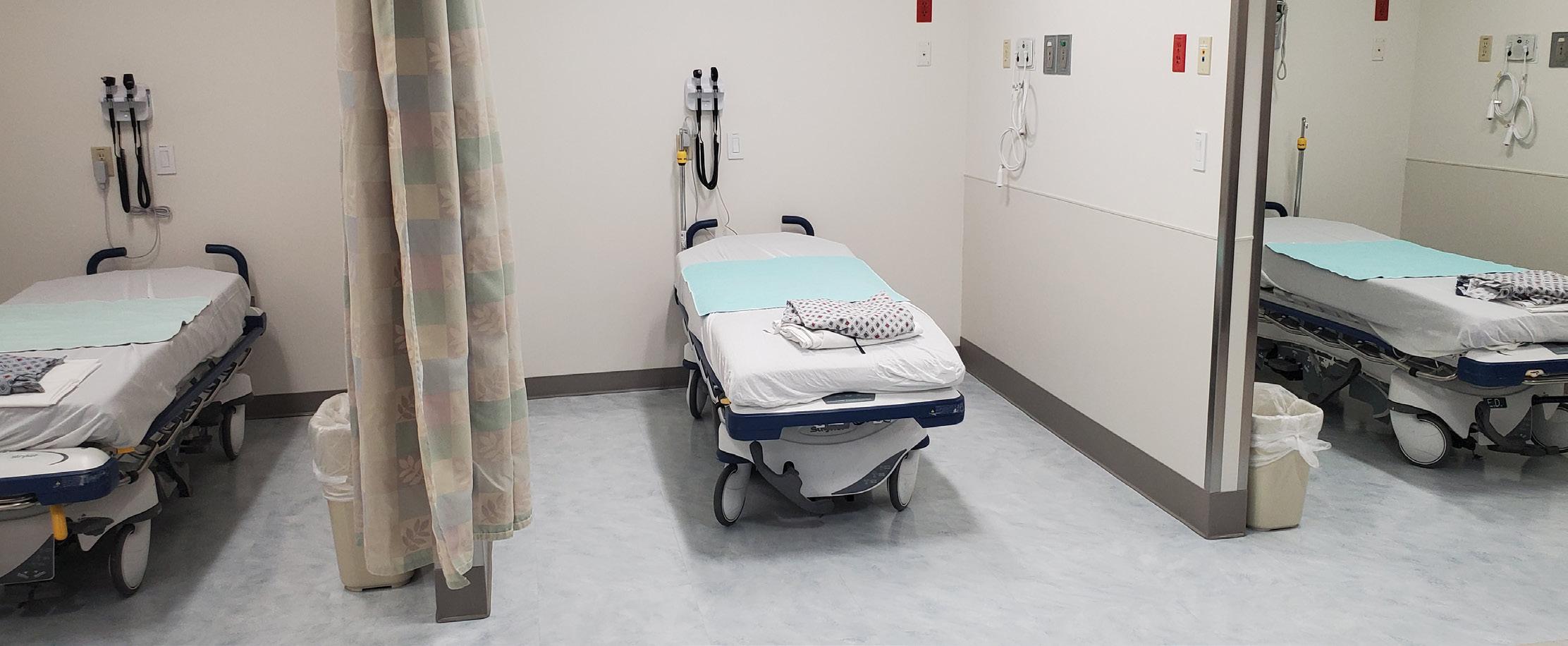
Mattera (R-St. James), and Suffolk County Legislator
Rob Trotta (R-Fort Salonga). Also present were members of several local Fire Departments and various EMS personnel.
Declan Doyle introduced Larry Castello, a patient who once presented to the ED at the hospital and spoke highly of the care he received there. According to Mr. Castello, “from the time I arrived, I felt at ease here.”
“It is not the walls of this building, or the building
itself, but the people inside these walls that are behind the quality care patients receive here,” said Castello.
St. Catherine of Siera Hospital is part of the Catholic Health System, encompassing six acute care hospitals, three nursing homes, a home health service, hospice and a network of physician practices. CHS is under the sponsorship of the Diocese of Rockville Centre and has close to 18,000 employees.
Michelle Pipia-Stiles, Director of Public Relations at St. Catherine, reminded guests that cardiovascular services of St. Francis Heart Center are now on the premises of St. Catherine, working handin-hand with the hospital’s emergency care team. PipiaStiles also pointed out the hospital is always striving to improve, planning expansions in their surgery and neurosurgery departments.

For more information on Catholic Health Services or St. Catherine of Siena Hospital, visit Home | Catholic Health (catholichealthli.org) or St. Catherine of Siena Hospital | Catholic Health (catholichealthli.org)
(Left
Larry
and Dr. Happes
Published by Messenger Papers, Inc. Thursday, June 20, 2024 Health 23
photo)
Castello
Catholic Health’s St. Catherine of Siena Hospital celebrates its newly renovated emergency department.
New Treatment bays
Nine Millionth Fan to Ballpark Ducks Welcome Record


Club Becomes First Team in Atlantic League History to Welcome 9 Million Fans
The Long Island Ducks welcomed their record nine millionth fan through the gates of Fairfield Properties Ballpark on Tuesday night prior to the team’s game against the Staten Island FerryHawks.
“This is another special day in the history of this great franchise,” said Ducks General Manager Sean Smith. “Reaching nine million fans is a testament to the incredible support from our fan base since we first opened the gates in 2000 and to the fun and excitement Ducks baseball continues to provide Long Islanders every year.”

On Tuesday, five-year-old Ethan Oldham, of Islip, entered through the West Gate at 5:56 p.m. with his Mom, Katie; Dad, Craig; and baby brother, Nolan. In doing so, he became the nine millionth fan in franchise history to attend a Ducks game in their home ballpark. Long Island became the first club in Atlantic League history to reach the milestone attendance figure despite having begun play in the league’s third year of existence (2000). The Ducks are also currently the Atlantic League’s all-time leader in sold out crowds with 707, have led the Atlantic League in attendance 17 times and currently lead the league in 2024 attendance as well.
Prior to Tuesday’s game between the Ducks and FerryHawks, Ethan Oldham was recognized during a VIP on-field ceremony for being the nine millionth fan. Sheldon Ellison, General Manager of the Levittown P.C. Richard & Son location, presented the lucky fan with a $1,000 gift card to use at any of the Ducks charter sponsor’s locations. In addition, the Ducks presented Ethan with a jersey featuring “9 Million” as the name on the back and the number “24,” representing the 2024 season. Ethan threw out a ceremonial first pitch, received a 2024 Ducks teamsigned baseball, and he and his family were upgraded to VIP tickets for the game.
The Ducks are in their twenty-fourth season of play in the Atlantic League of Professional Baseball and play their home games at Fairfield Properties Ballpark in Central Islip. They are the all-time leader in wins and attendance in Atlantic League history, led all MLB Partner Leagues in attendance in 2023, and have sold out a record 706 games all-time. For further information, visit LIDucks.com or call 631-940-DUCK (3825).

About the Atlantic League of Professional Baseball (ALPB)
Celebrating its third decade, the Atlantic League is Major League Baseball’s first Professional Partner League, a player gateway to the major leagues, and a leader in baseball innovation. Over its 25-year history, the ALPB has sent over 1,400 players to MLB organizations while drawing over 47 million fans to its family-friendly ballparks. Please visit www.AtlanticLeague.com.



Thursday, June 20, 2024 Published by Messenger Papers, Inc. Messenger Spotlight
Right and below photos credit: Tim Walz
Photo Credit: Matt Meduri



 By James Haupt
By James Haupt


























































































 By Matt Meduri
By Matt Meduri









